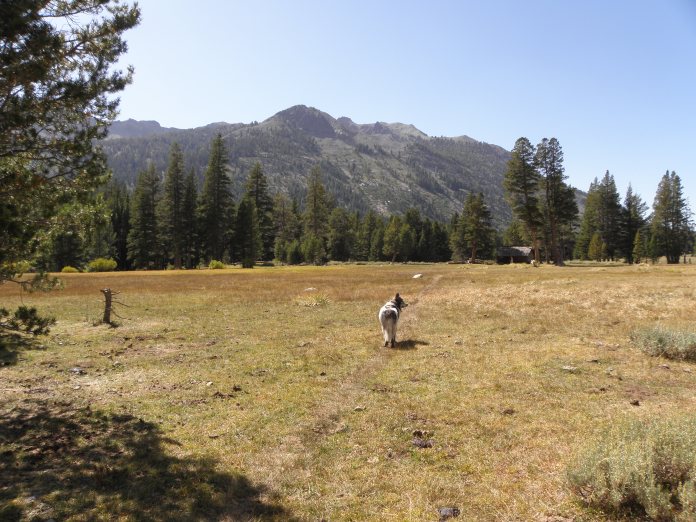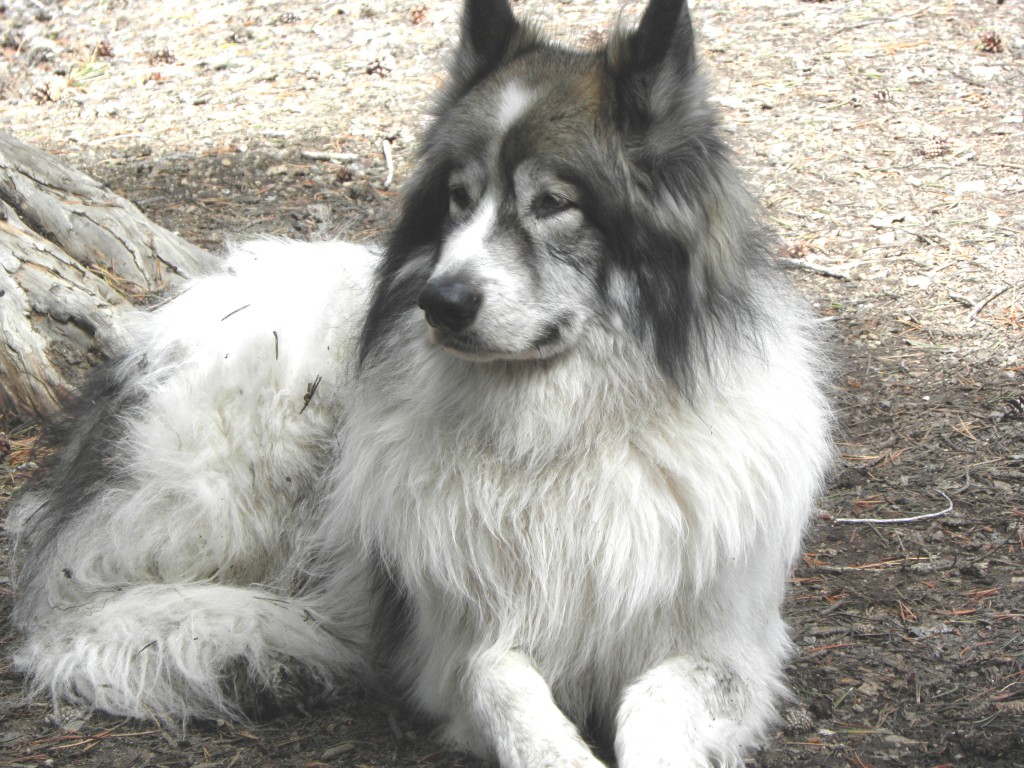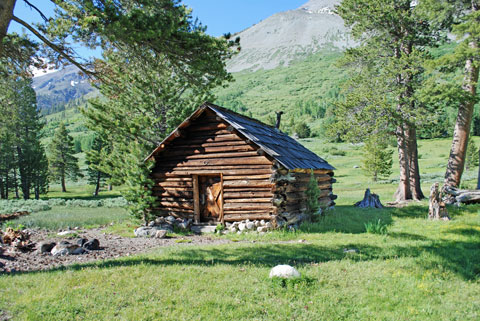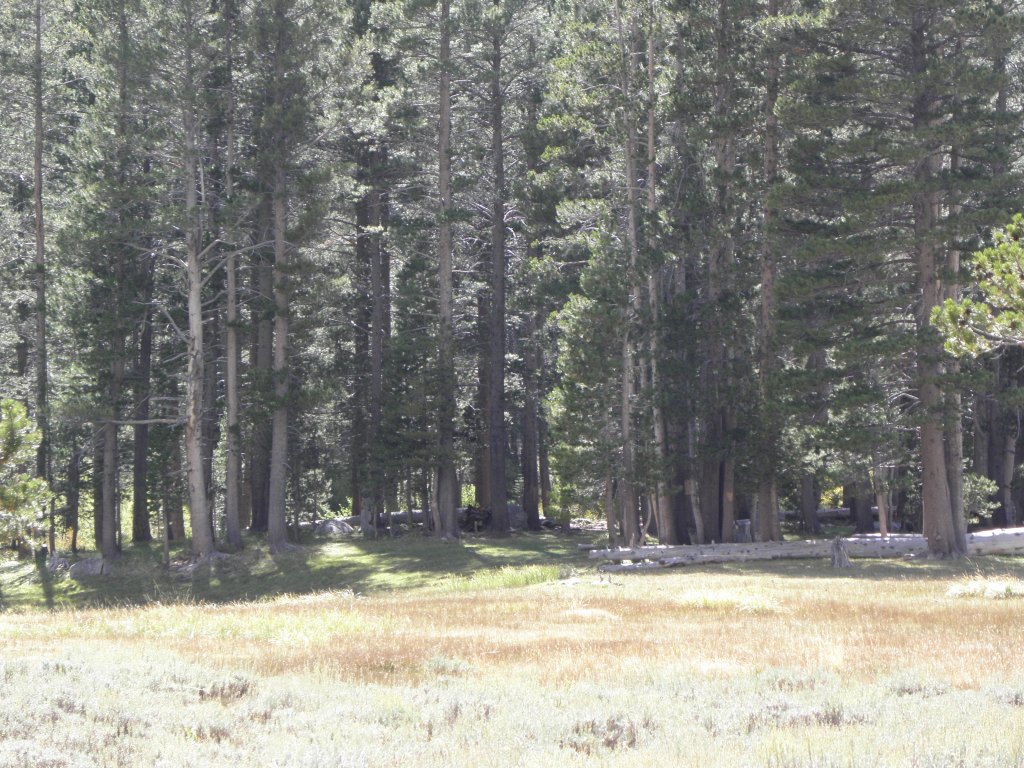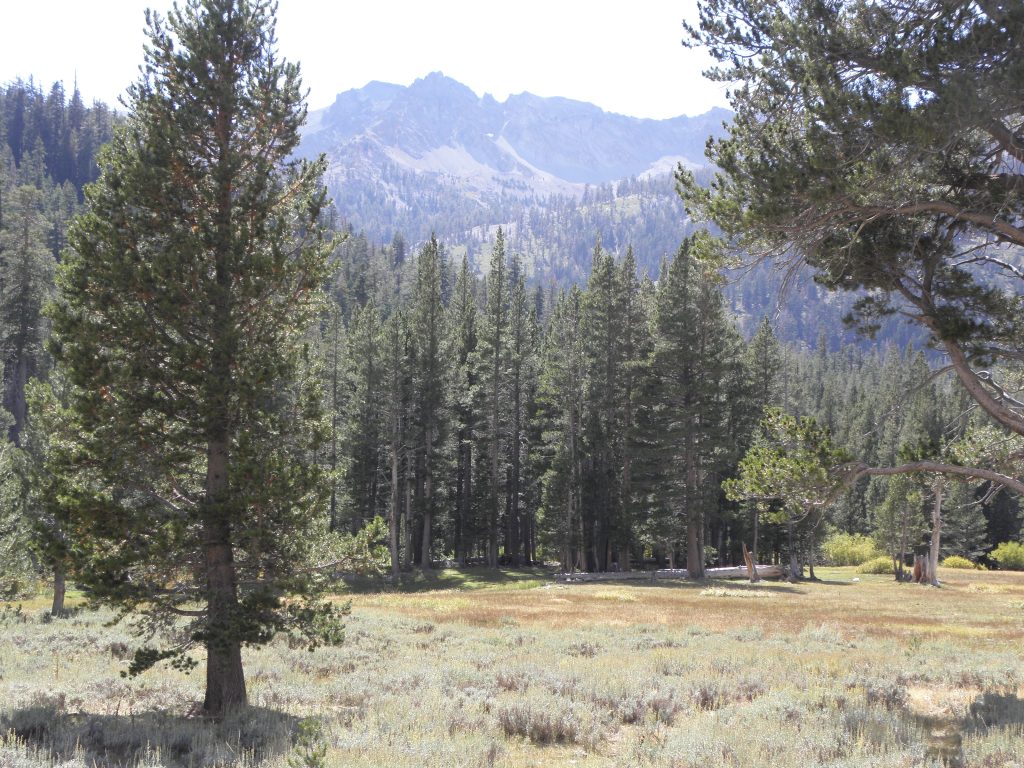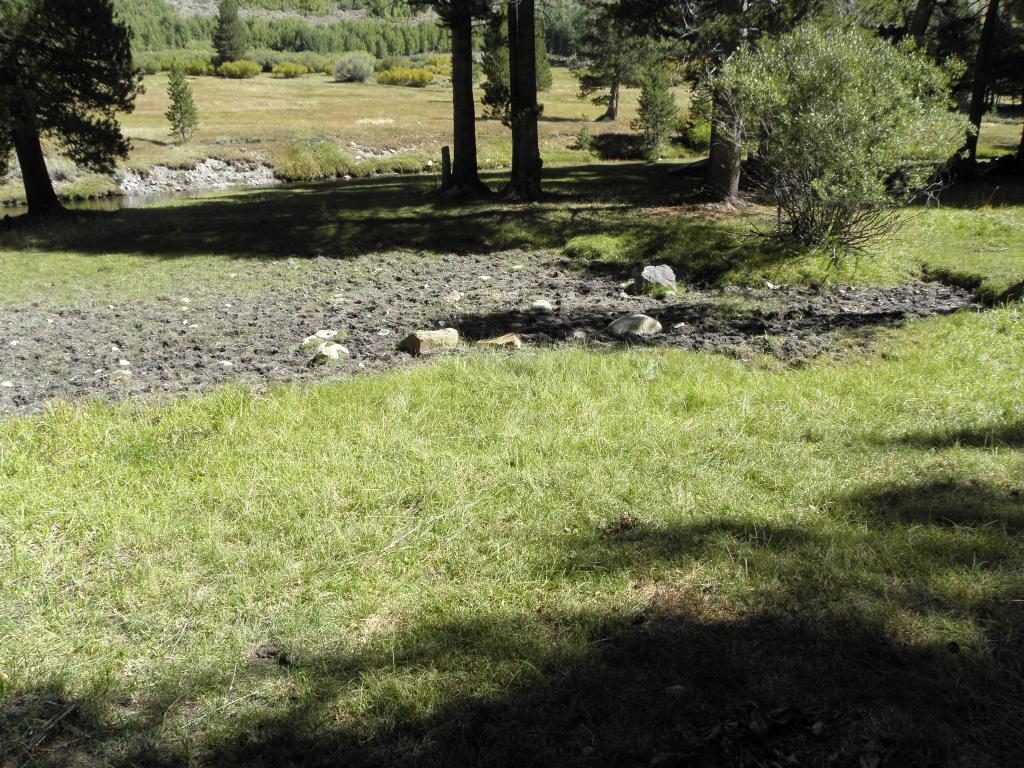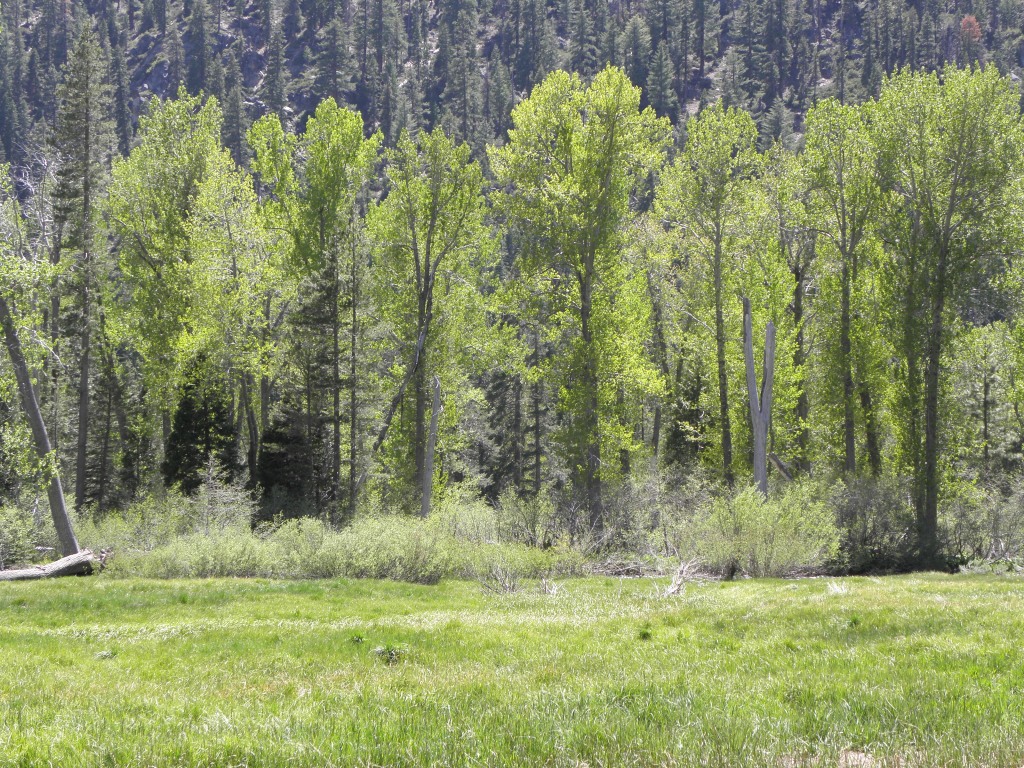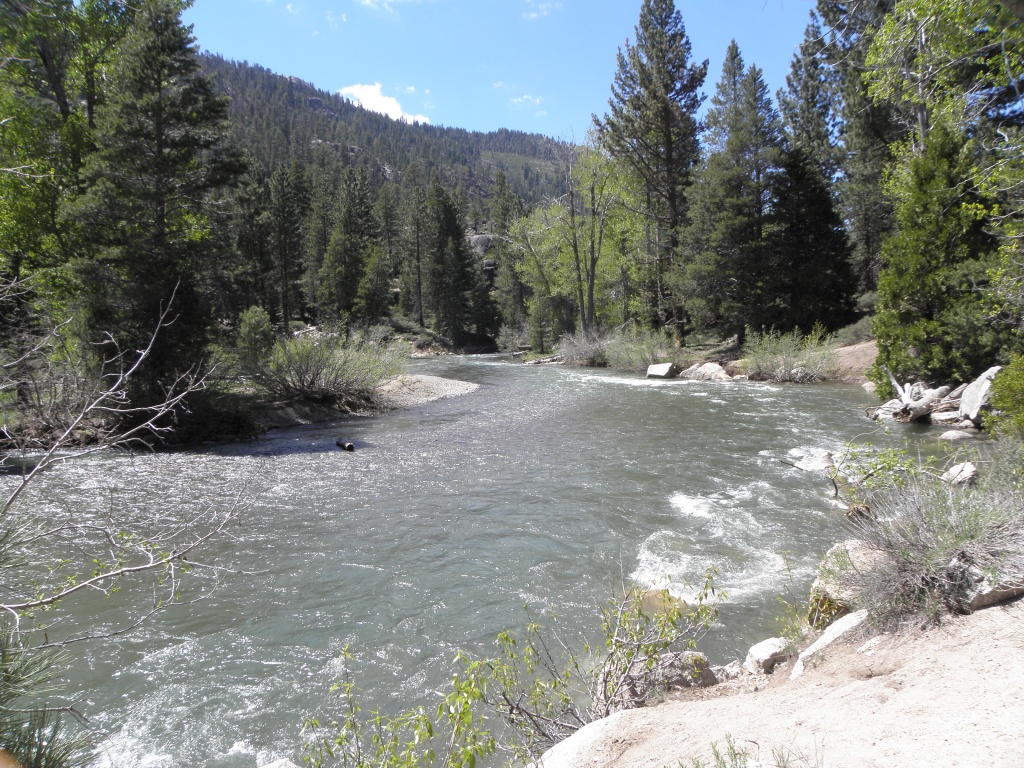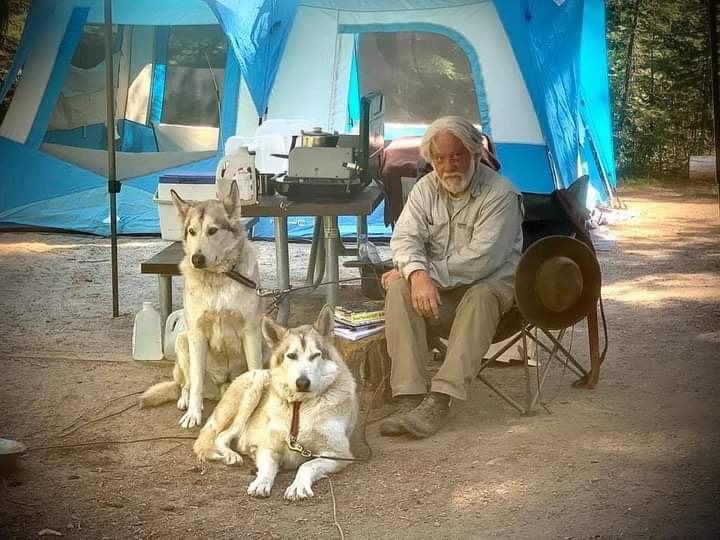Our Journey Into The Wilderness – Part 7
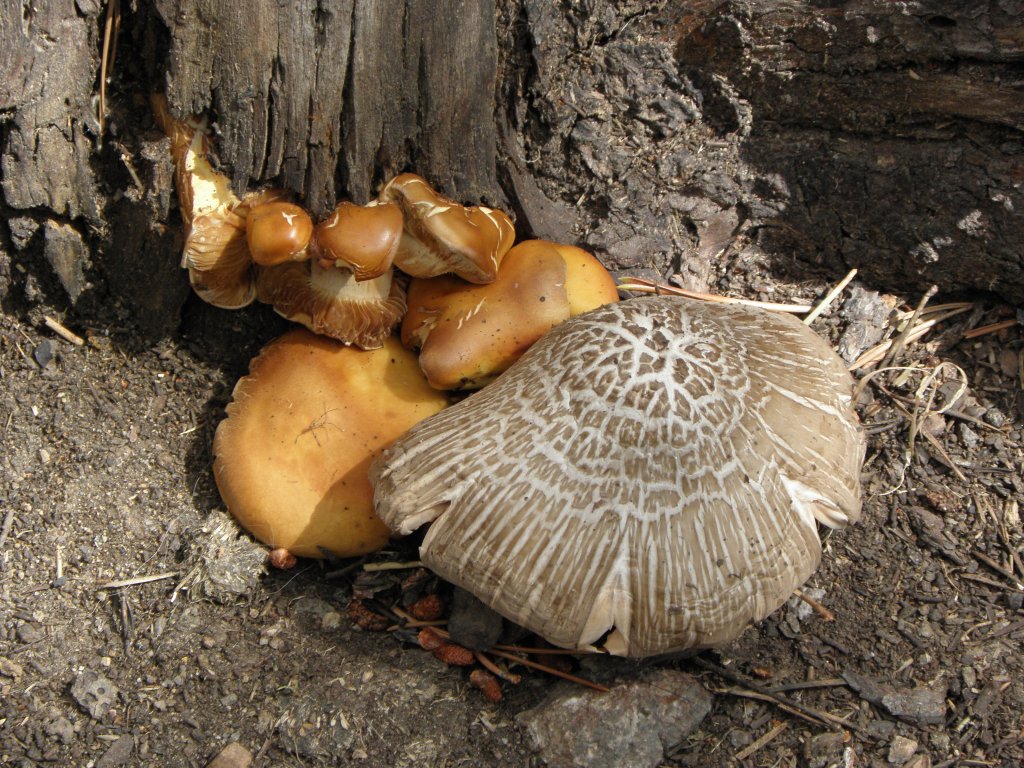
CAMPING IN THE EMIGRANT WILDERNESS – OUR 24 DAY STAY AT KENNEDY MEADOWS
Nature has a way of bringing us back home to who we truly are.
August 24, 2009 – Monday
The planning of the dates were important because I wanted to miss the main hunting season that would begin in the middle of September. This beautiful and pristine place would become filled up with hunters. So our 24 days would finish about a week prior to the start of hunting season for rifles.
Shiloh and I picked up Marilyn from her class that she was teaching at in Berkeley around 12:30 pm, where I was suppose to meet her in the parking lot. She was running a little bit late. Like my usual self, I was getting a bit antsy and wanting to get on the road. Once she arrived we began stuffing her gear into my truck bed.
Once again, we were again off for a wilderness adventure, me, Shiloh, and our new camping companion, Marilyn. I was hoping to get an earlier start, but lost about an hour picking up Marilyn. I did not want to get up there too late. We had about a 31/2 hour drive.
On the way up, we took care of our wilderness permit at the Miwok Ranger Station. The gal that helped us recognized me and Shiloh from our June trip. All the women there enjoyed seeing Shiloh. He was a favorite at the Ranger Station, he was like a celebrity. I told the gal how long we were going to stay – three weeks. She told me that there was a rule of how long one can stay in one place in the wilderness area. She told me she thought it was twenty-one days, and she went to double check, and she couldn’t find any restrictions for Kennedy Meadows. One gal said, no one will know anyway. It is nice having friends at the Ranger Station. I thanked them, and we then headed to Kennedy Meadows Resort to rest, and organize our departure for tomorrow.
Once we arrived at Kennedy Meadows Resort, we got settled into our one room cabin, and Shiloh and I took care of arranging our departure with Matt, the owner of Kennedy Meadows Resort and the Horse Packing Station for tomorrow. It was cooler up here than the weather forecast, which was fine with me and Shiloh.
I was looking at using the same campsite I had in June and Matt mentioned the lack of firewood around that campsite and it brought back memories of the little wood that was there before. It would have also been too small for two tents. He suggested a campsite he liked and uses, and there is an abundance of firewood. I told him we would think about it.
It was nice being back up in the mountains again and looking forward to spending three weeks, hopefully in the wilderness. Marilyn and I had dinner at the restaurant while Shiloh was lying outside on the veranda. As usual the dinner was not that exciting. It seemed Marilyn felt comfortable about this whole trip and seemed relaxed. After the meal we headed back to the cabin to get a little organized then went to bed for an early start. Marilyn had one bunk, I had the other and Shiloh had to sleep on the floor this time with all our gear. I did bring his bed, so at least he got to lay on that.
Running through my head all night was the question, which campsite should we use? I decided hesitantly on Matt’s suggestion because of the firewood issue and it was highly recommended. There should not have been any question on the recommended campsite. Always listen to the outfitter, my stubborn mind was telling me. I finally fell asleep at 3:00 am.
Once again I planned on an early start for the next day. I wanted to get up at 5:00 am the next day which turned out to be 5:30 am and rushing around like a chicken with it’s head cut off to make up for the half hour lost.
My experiences of frustration on simple survival tasks such as starting a fire, I think has been ingrained in our way of thinking by our society. The concept of the quick fix, getting thing done quickly or expecting things to happen quickly. Learning a new skill always takes a certain amount of time to perfect or master that skill, even if it seems simple. Nature teaches us to slow down, and be present, to be aware. But most of us want it to happen right now, and having the expectations that we can do it quickly especially when we think it should not take us that long to do.
A good example of this is, starting a fire with a bow drill. The process is not a quick process. You first must look for and find the right materials for the fire bow, then putting everything together for it to work. You must get the right materials for a tinder bundle, collect the wood required, starting with kindling, and progressing to larger pieces, to keep the fire going once you have flame. And the process of getting the beginnings of a fire going requires making sure the fire has enough fuel, oxygen, and heat. I find it a very meditative process as long as it is not important to get a fire going quickly. One also may learn to respect fire. Because it was summer, we had more than enough dry wood. I always had the needed firewood next to the fire pit, making it easily accessible for feeding the fire once it is going.
Les Stroud in one of his shows actually took him eight hours to get an ember from the heated wood dust into a flame by using the fire bow. Something he had already mastered and still he was having problems. As with many bushcraft skills, it takes time and one needs not only the knowledge of how to do the skill, and also have the patience to learn and master the skill. And know it still won’t always be perfect at times. There are usually no quick fixes in the wilderness. I learned this with using a metal match, or ferro rod. I thought it would be easy, and it can be if one has the right flammable materials, and the experience using the ferro rod. And if you know the right techniques for different materials, and the right techniques for the density of the ferro rods.
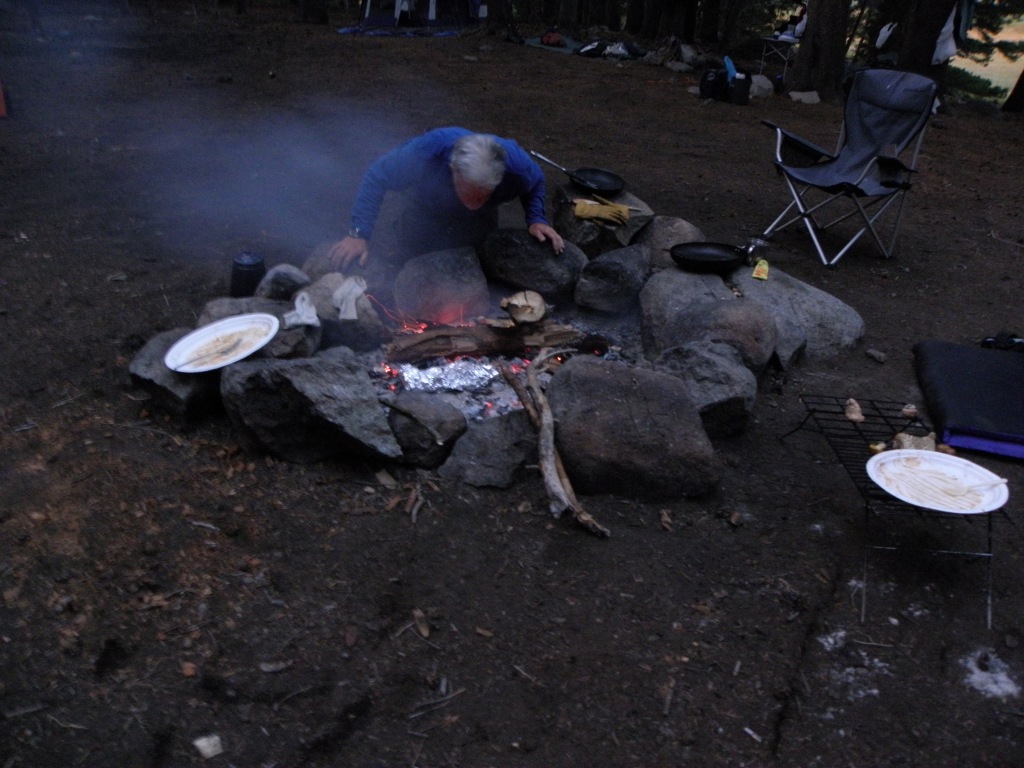
August 25, 2009 – Tuesday
I had set my alarm on my new watch not knowing if I set it correctly and hoping it would go off. If it went off I did not hear it, but heard Marilyn get up and the time was 5:30 am. I jumped out of bed, took a shower, took Shiloh for a walk and packed everything into the truck to take to the loading dock at the pack station. It was a beautiful morning, cool with the scent of being in the mountains permeated throughout the canyon. I was running a half hour late from the planned schedule I had made for myself and tried to make up for lost time. I ended up at the loading dock at 7:00 am and a half hour late. Rushing around trying to get everything done I felt I was running in high gear and my heart pump’in. I figure it would take three pack animals to haul our stuff to our camp and was surprised when they told me it would take four pack animals. Miscalculated again! It really was not a big deal except for the fact it would cost another $130.00 round trip for the extra animal. I actually did figure it might take another animal, but hoping otherwise.
I did not want to go through all my stuff to figure out what to leave and what to bring. From my planning the trip for a month I knew I wanted to bring those things, so another pack mule it was.
Once I thought of the idea of packing in my gear by a pack station while planning my June trip, I have become convinced this is the way to go – the only way to camp. You can choose to ride on horseback to the campsite or hike in. I chose to hike in because of the exercise and because it would not have worked very well with Shiloh nipping at the heels of the horses and mules. The horses are not crazy about Shiloh, but the mules freak out, and will kill him if they have the chance. They don’t know what to think about him, but it is certain, they do not like him. Another advantage to packing in is that you only carry a day pack and you can bring as much stuff and stay as long as you want, that is if there are not any restrictions to the time you stay in one place.
After Shiloh and I got everything taken care of at the loading dock, We met Marilyn at the restaurant for a little breakfast before we started on our hike out. Shiloh waited patiently outside and would soon enjoy a serving of bacon. I was finally able to sit down, take a deep breath and relax some from my frantic rush to get everything done, and the packers on their way.
Shortly after I was done with my half eaten pancakes I was ready to get on the trail. It was a perfect day for a hike as for the nice weather. There was a little nervousness, and excitement in me about getting started, about these 24 days. About being alone for 18 days, about how it will go with our new camping companion, about the new campsite, and the adventure, and beauty in discovering being in the wilderness again. There is also a comfort of knowing the trail getting up there, and having a bit of a familiar knowledge of Kennedy Meadows. Marilyn was going to stay for six days and Shiloh and I for twenty-four days – at least this was the plan. It would be me and Shiloh alone for 18 days.
It took us about four and half hours to get to Kennedy Meadows. We took our time to enjoy the beautiful scenery of the mountain landscape. I was doing pretty well with no issues with the elevation change, and felt energized. My lungs were still adjusted to the thinner air from our trip here in June, and probably from our two camping trips in the mountains after that. It felt I was gliding along the trail with little effort. It felt good. With that, I didn’t want to push Marilyn too much. I did not want it be a grudgingly, brutal hike for her. She was probably in better shape than I was, but I was acclimated to the higher elevation change.
For me the hike was much easier than my June trek and Shiloh didn’t seem to have much of a problem either. Shiloh remembered the trail as if it was yesterday. Marilyn seemed to be doing fine as well. She told me she was a little sore from a previous injury to one of her knees, but she did not slow us down a bit. We weren’t in any rush so we took our time on the eight mile hike. Shiloh knew where we were and took the lead on our trek to Kennedy Meadows. It was an enjoyable hike. This time, I packed all his food on a pack mule, so I would not have to deal with adjusting his pack constantly. He was free to roam.
Everything looked familiar on this trip to me and Shiloh, and Shiloh found his pond for a soak and drink. I could tell he was excited and happy to be back in the wilderness. Just past the pond we crossed a little trickle of a stream running across the trail, and on the right side where it was coming down from the mountains, was a small waterfall that created a small pool at the bottom. Both Marilyn and I had a little drink from the fresh cool water, with Shiloh sharing in it as well. I thought the water would be okay to drink. It was coming from a natural spring or from runoff high in the mountains above us.
Along the trail we found currant berries and gave them a try. They weren’t as tasty as the current berries I had in the eastern Sierras – probably a different variety. It seems from what I gather, I found more berry bushes with berries on them in September in the eastern Sierra Nevada mountain range then on the western side.
On the trail we saw a lot of manzanita with it’s white berries. The berries, and the flowers are edible, and if the flowers are put in water and let sit over night, it makes a nice refreshing drink. The manzanita also has medicinal properties. The flowers were gone, and I wasn’t sure about the berries being edible at that time. We also spotted a plant with white berries and the leaves that looked very similar to the blue berry leaves. I thought it might be edible, but since I was not absolutely sure, I refrained from taking a nibble. As with many plants we saw on our hike. We also saw some sequoia along the way, in one small section of the trail.
When I was on my second horse packing course on a month of September a few years back, it was the first time I got to experience the wild blueberry, currents, and wild strawberries in or right next to our camp. I picked a bowl full of the currants and strawberries and someone else picked some blueberries, and for breakfast for the group of us we had fresh picked fruit from Mother Nature. It was an added treat to the whole experience being out in the wilds, at least for me. Not sure if everyone else was as excited about this find as I was.
I felt good on the hike up and was excited to be going back to Kennedy Meadow with Shiloh, and sharing it with Marilyn. I was glad she came along.
When we finally arrived at the cattle gate entrance to Kennedy Meadows I told Marilyn we were almost there. We headed towards Kennedy Creek to our right, thinking the camp was in that direction. Although I was here back in June, I did not really do that much exploring of the area that still seemed unfamiliar to me. Once we got to the creek there was no sign of our camp, so we sat for a bit to rest our tired feet and soak up our surroundings. It also gave Shiloh a chance to cool down in the creek while having a drink, and Marilyn taking her shoes off to soak her feet in the cool water. I was a bit anxious to get going to find camp, but I knew Marilyn wasn’t, so it got me to slow down some and just relax and enjoy where we were at. From hiking in the woods for most of the last part of the trail, then seeing the area open up to a beautiful open alpine meadow surrounded by mountains, was amazing to say the least.
I knew our stuff had to be close by.
The creek still had a good amount of water in it and I saw a lot of small trout swimming about. That meant good fishing, I hope. I was going to try and do a lot of fishing this trip. We weren’t sure exactly where the campsite was so after our nice rest, we hiked along Kennedy Creek until we found the two log bridge spanning the creek to our camp and spotted our camping gear there. After crossing the creek it was just a short hop to the camp on a little rise from the creek. It was a welcome sight to see. From what I saw, it seemed we were the only ones there.
We arrived at our campsite at 1:00 pm.
We had good weather all day and did not have to worry about any chance of rain, so we took our time getting camp set-up and ready for our long stay.
Throughout our camp and in the surrounding forest there were currant berries and a lot of gooseberry bushes. The actual gooseberries were not overly abundant, but I enjoyed their tartness as a tasty snack. There were a lot of strawberry bushes, but no strawberries. I was surprised I found no strawberries during this time of year and was a little disappointing, because wild strawberries though small, are very, very tasty. Looking around, there were no blueberry bushes around either.
Once we were in camp, I checked to make sure none of our supplies was damaged and everything checked out to be okay, and as usual the wranglers covered everything with tarps that I brought just in case it did rain. The wrangler did a great job in getting our supplies here safely and in good shape. The camp is huge. Kennedy Meadows Pack Station used it for their group camping trips to Kennedy Meadows. The campsite was right along the creek on a slight rise and lots of trees surrounding the site. It backed into a wooded area. I checked the camp out carefully and was somewhat disappointed, not what I expected in my mind’s eye. I wished we chose the campsite I used on my June trip. I loved that campsite, but it would have been too small, and again, the issue getting firewood.

I soon realized it was a pretty nice site. We also had more privacy, a nice view of the creek, and meadow. What was I complaining about? This site had lots of firewood close by as well. I can’t say this for others, but I guess I have a particular vision and expectations of what a good campsite should be, especially if I am going to be staying here for a long period of time, and calling it home. It has to have a good feeling to it. I want it to feel like home. This camp did not, at first glance. The site felt too large for just the two of us and I was thinking if I will feel comfortable here during our stay alone. I think I was feeling an unwarranted uncertainty about being comfortable with the site when Shiloh and I were alone here. It only had a few small opening into the meadows and views of the mountain peaks. One opening to the main meadow and a small opening to a smaller meadow to the southwest of us. Though the camp was large, it felt too closed-in for my liking. For most of the day the camp remained shaded with streams of sunlight beaming into camp that followed the path of the Sun. But, we were here, and it would have been a lot of work to move camp, so I tried to look at the positives side about the camp. I also thought, if I were in a survival situation, you don’t always have a choice of a perfect camp, nor would you find one unless you were very lucky, or even a comfortable camp. Survival campsite also have a different criteria than a regular campsite.
A big plus in the camp was the firewood – lots of it. We even had firewood stacked at our camp from previous campers. I soon got over my obsession of the perfect camp. This practice of leaving firewood in camp for other campers is frowned upon by the forest service and will be discussed on our next trip to Kennedy Lake that Shiloh and I took in June of 2010 with an old friend. Another good thing about this camp is that it is on the west side of the creek, and that will provide us with more of a tendency for hiking and exploring on this side. It must be a mental thing, because for most of our stay here, we did explore more of this side of the creek.
Just a side note: I write a lot about the wild edibles that can be available in nature during different seasons, but in a survival situation, one can not survival on wild edibles alone. One needs good sources of fats, and proteins as well that comes from animals, and fish.
After my inspection of our gear, we got our tents set-up and the camp organized. Shiloh and I had our own tent and Marilyn hers. Once I got my tent set up, I helped Marilyn with hers. I then got a fire going. We had enough firewood that had been left by previous campers to carry us through for a couple of days, so I didn’t have to do any gathering or chopping of firewood. We had a huge fire pit as well and allowed us to modify it if desired.
Tonight after getting oriented to my surroundings, I realized we were very close to the log cabin and that gave me a sense of where I was in the valley and seemed to ease my mind about our campsite some. It quickly became a place that was familiar to me. I knew we were close to the natural spring that I found last June where we could get our drinking water and it was still flowing strong. It was only a short walk from our camp and being a small relief from having to use the water filter for our water for three weeks.
There were about 150 head of cattle scattered throughout the valley and I am sure the water was possible full of Giardia. And there is more to worry about with grazing cattle around. The Outfitter told me cattle does not have Giardia, but indeed it can. Even with the water filter I didn’t like the idea of getting water from the creek. Going to the spring made for a nice walk and to enjoy the beautiful mountain scenery. And I suppose even the spring can be problematic in catching something that will make one sick. I also knew we were close to the stand of aspen with all the vegetation I had seen in June. I was beginning to feel at home once again.
The main meadow was still surprisingly boggy for late summer and there were even small patches of snow still remaining on some of the north facing mountain slopes. I was a little concerned about the make-shift cattle fences preventing us from getting into the aspen grove and noticed the fencing was set further back into the grove allowing us access into the area of aspen. The fencing for the cattle was a barrier I thought should not be in a true wilderness area which Kennedy Meadows is designated as. Many others complain about grazing cattle, and sheep being in designated wilderness areas. Marilyn showed signs of not being too crazy about the cows, so she stayed close to Shiloh and I for protection when the cattle were around. The fencing really didn’t help keep the cows in. They would just jump the fence or walk through it. The cows would tend to move from place to place, meadow to meadow, mountain to mountain. There would be times we would only see a few and others times a great number of them. They really did not pay much mind to us, but always gave Shiloh the watchful eye. He always enjoyed chasing them around. He just wanted to play, but the cows were really not that interested.
Besides all the damage cattle can do to an area, there is a plus to their presence in a survival situation and that is the cow pies, or for that matter, any situation. Dried cow pies put into a fire helps keep the bugs away with the smoke it creates, and they can keep a fire smoldering for a couple of hours where the fire can be easily restarted. To me, burning cow pies smells like a sweet smelling cigar. Not bad at all. I didn’t even hear Marilyn complaining about the smell. She even helped in gathering a bunch of them and got pictures to prove it.
I did bring my camera this time.
On this trip I brought more things to help better organize the camp and brought Shiloh’s bed so he would be comfortable. We brought the big tent for all our stuff, and for comfort including an air mattress for me. As backup, I also brought the small self-inflating air mattress if needed just in case the other air mattress failed.
The gear I usually bring up on this type of trip are, a tent for me and Shiloh, sleeping bag and air mattresses, Shiloh’s bed, enough clothing for our stay, food for our stay and about four or five days extra food for emergencies in case we get stuck up here (I also made some bannock for the trip) an ice chest, panniers to keep the food in, and protected from critters such as the mice, a propane stove, and fuel, propane lantern, water filter, flashlights, chair, a bag full of my books on survival and wild edible plants, topo map of the area, I had a small day pack with extra batteries, a good first aid kit and other necessities, another day pack with all my fire starting gear, a number of knives to test, a multi-tool, butane lighters to test while up here, and some extra needed gear such as miscellaneous survival gear. In my day pack I carried with me, I had a smaller first aid kit, some fire starting material, a poncho, camera, an emergency locator beacon and some water bottles. I also had cookware that I thought I would need, my tin can I use for varies things, tarps, saw, axe, hatchet, fishing gear and firearms. The firearms are for possible hunting of small game, and for protection. Most people think they don’t need a firearm or think they are not necessary, and most backpackers don’t carry them because of the weight, and also feel they are not necessary to have, but because I am here for a long period of time I choose to bring at least a pistol and rifle, if for anything else, for emergencies – being prepared for the worst. Three shots in succession, can signal someone needing HELP! I actually bring the pistol for protection of Shiloh that you will soon read about further in the story.
This might seem like a lot of stuff and it is, but I will be up here for three weeks and I want to be comfortable, and I will be testing gear and equipment to see how well it performs. I brought gear I would need in a survival situation and gear for just everyday living in the wilderness. And I do bring a lot of books that I may need for animal, plant identification as with survival books, and as always my journal. I also bring backup supplies and equipment if something breaks.

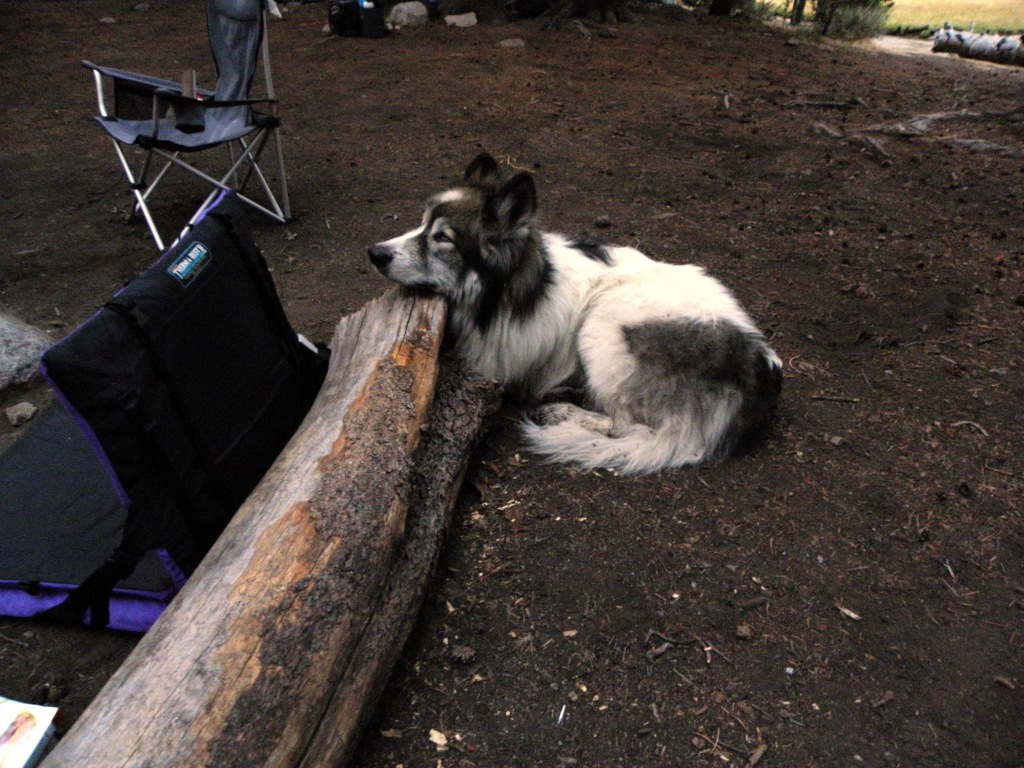
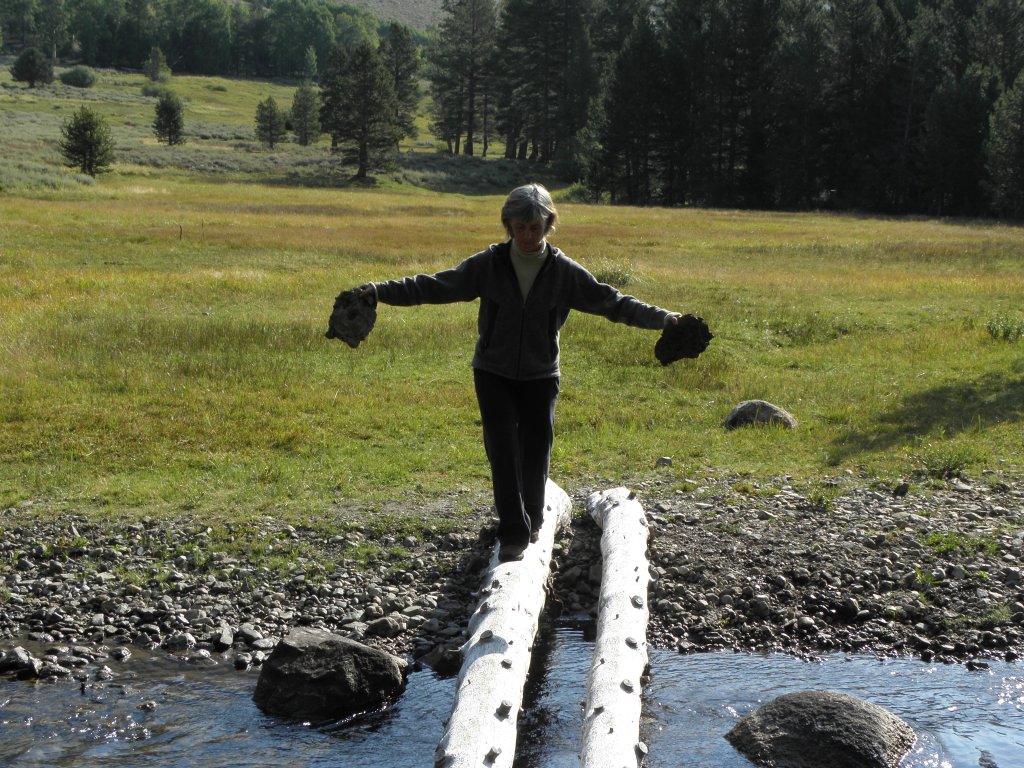
The subject of crapping or shitting in the woods came up by Marilyn, and I shared a technique I found that works quite well and is very comfortable for me. I had the same question on my June trip and thinking of the best approach to this required need, besides just squatting, that I have used in the past, but don’t much care for. In the past, I would squat, which is uncomfortable, and potentially undesirable, and messy in missing the prescribed target and getting caught possibly where you prefer it not to be. There is sitting on a small downed tree and extending beyond for the intended target which is anywhere past where you are sitting and hopefully landing on the ground, then there is what I consider the best position thus far that I have found. And I did not hear any complaints from Marilyn. I find a place that is somewhat flat and next to a good size downed tree, or large enough to support ones back. Find a relatively smooth surface on the side of the downed tree with no knots or branches that could poke you, then in a sitting position, lean back on the side of the log. The log supports your weight and while you are doing your business you can enjoy the sights, or read a book if you so feel inclined. I have never enjoyed this process more then when using this technique. You can choose to dig a hole prior too or after finishing. If you want to learn more about the etiquette of shitting in the woods, I would recommend the book, “How To Shit In The Woods” by Kathleen Meyer. It really is an enjoyable read and will keep you laughing even into the woods. I might add, my technique is not in the book.
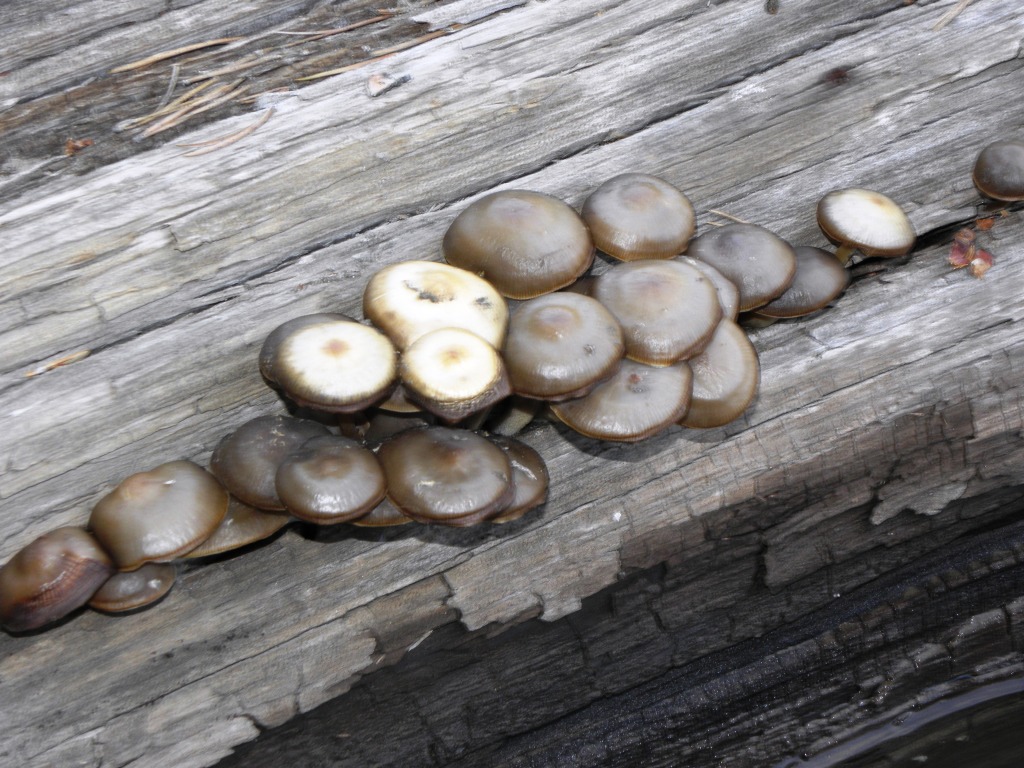

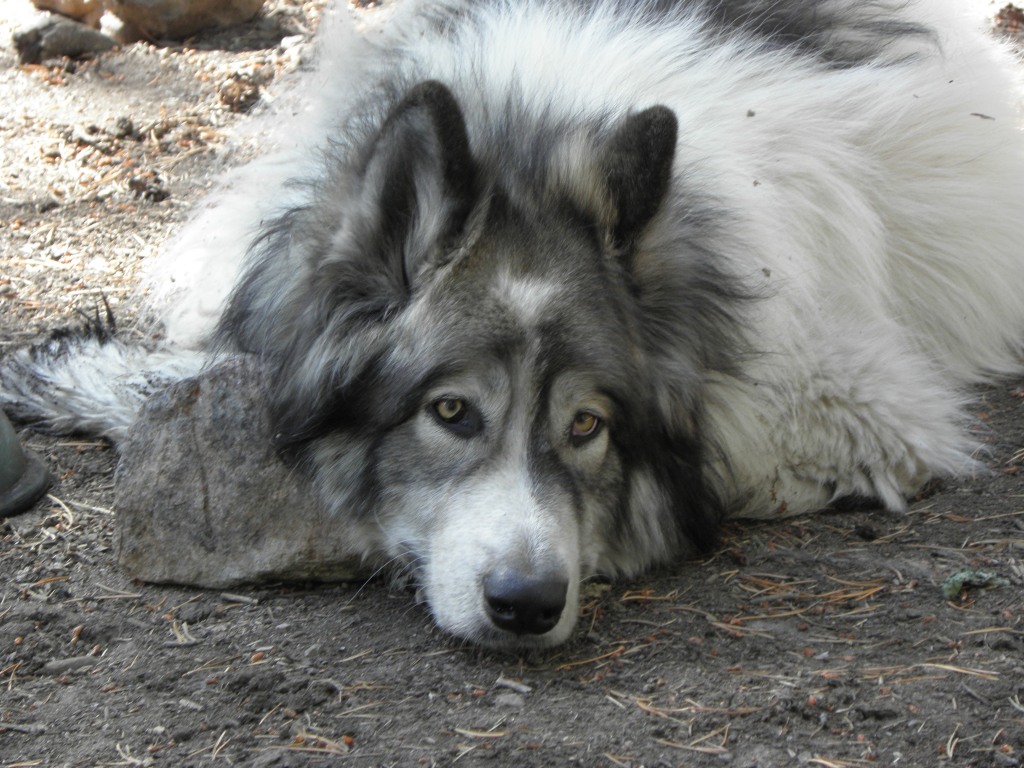
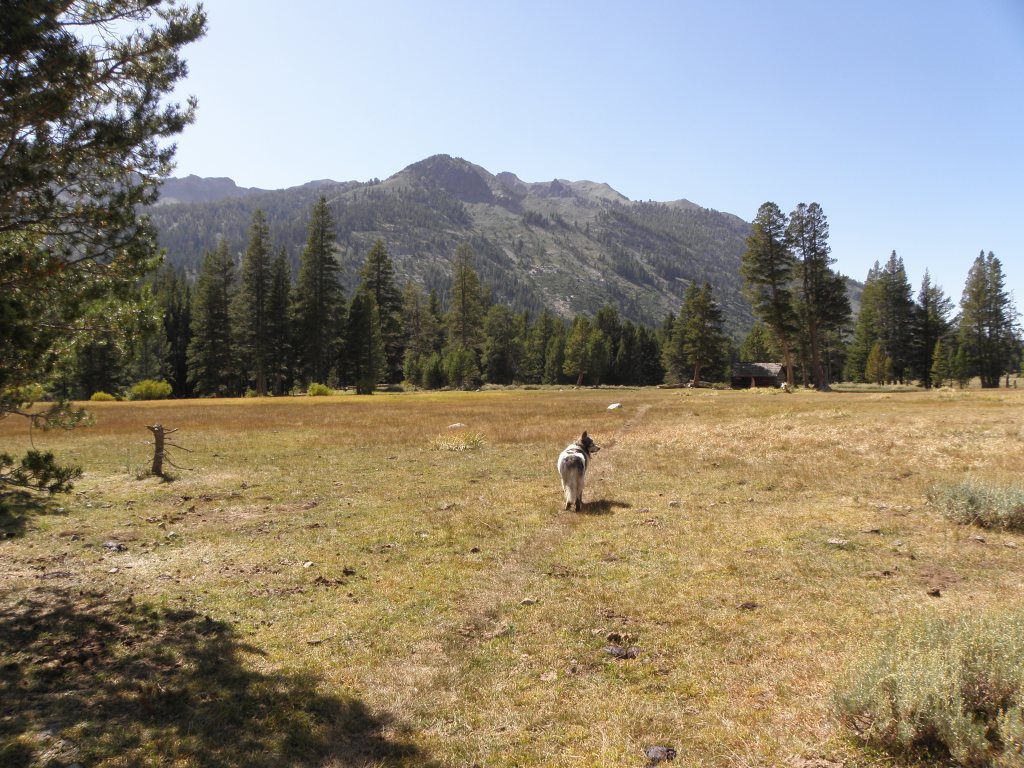
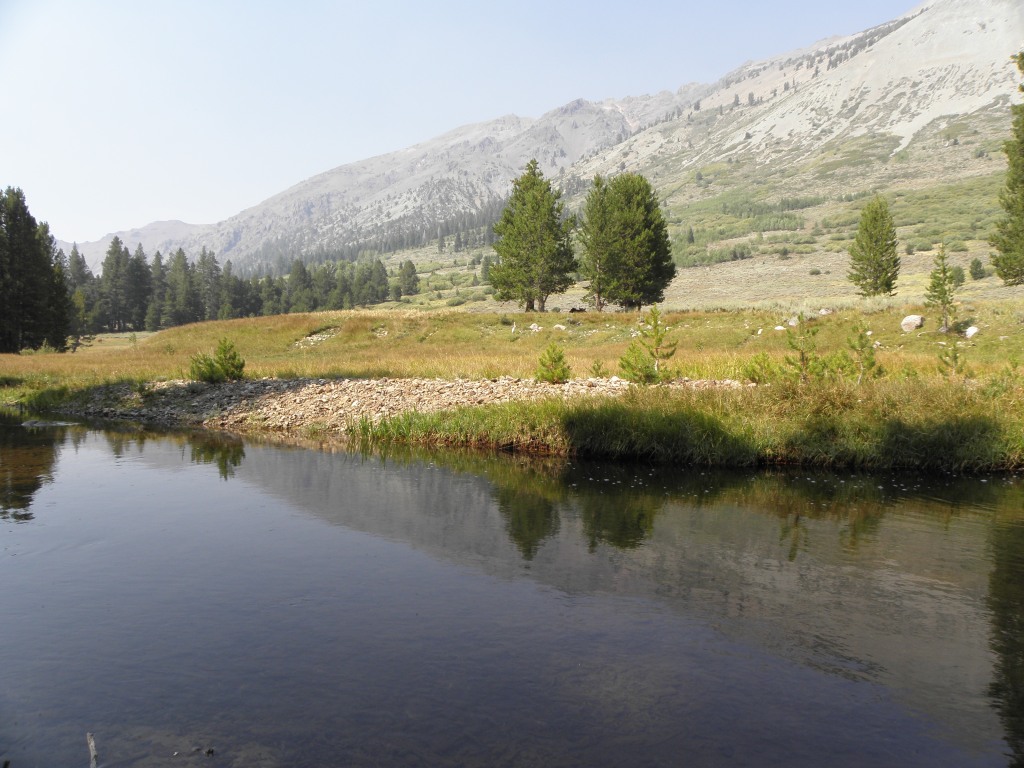

August 26, 2009 – Wednesday
For our first night back to Kennedy Lake, I slept well last night with the exception of my air mattress going flat in the middle of the night. It did seem to keep enough air that it did not go totally flat. I don’t think I had the valve tight enough, because the rest of my stay I only had to add air every few nights. I was also curious about how long the pump would last, but it did its duty faithfully the whole three week stay which actually surprised me. Shiloh was comfortable the whole night on his bed. All is good. After the first night deflation of the mattress I kept my reserve mattress underneath my main mattress. The double mattress worked well.
Last night Marilyn was obsessed with bears coming into camp. I tried to convince her not to worry, but she did not buy into it. She wanted to have Shiloh sleep with her, but I knew Shiloh wouldn’t go for it. He loves people, but he is a one man dog and always sticks next to me whether at night or during the day, and I feel the same about him. Although we had no encounters with bears nor did we even see a bear, or signs of bear, Marilyn was convinced a bear was going to come visit her in the dark hours of the night. To be honest, at first I was having those thoughts as well. With black bears, I tend to be more concerned with them destroying gear.
The howls of the coyotes were ever present throughout the night. It was a wonderful sound to hear – they give a definite presents up here. Shiloh did not seem too bothered by them.
Early in the morning I was being summoned to get up and make a fire. I think Marilyn figured it was my job, which I happily took on graciously. It was 7:00 am and checking the temperature it was 30 degrees. On this trip I picked up a small thermometer to keep track of the temperature. For me, the feel of the slight alpine chill in the air was refreshing. I was happy to be back in the mountains. The Sun begins to warm things up quickly as soon as it rises above the high mountain ridge. It should be in the high 70’s today.
I am beginning to get used to our new camp and our new home.
Today Shiloh and I will spend the day becoming familiar with our surroundings, getting the camp organized and gathering firewood. Though we have enough firewood for a couple of days, I want to keep a good supply in camp, that becomes almost a daily chore in camp. Because pine is a fast burning wood, I am usually always looking for firewood while doing other things, and always bringing some back with me when returning to camp. It becomes what I just do and can’t pass up picking up good pieces of wood, or making a mental note where to go back for it. A good exercise to practice is, always get firewood that is away from camp and leave the firewood that is closest to camp only if you need it during the night or for an emergency. If you are in a survival situation, and when your energy levels are low, you will have firewood close at hand. Conserving energy is a key component in survival. Having a fire is part of camping when one does it respectfully. It is a gift from nature that has been with human kind for tens of thousands of years.
As always, my morning routine first thing is getting the fire going, getting the coffee on, maybe taking care of small things until the coffee is done, and then finding a spot to sit where I will get warmed by the Sun, enjoying the view, sipping my fresh perked coffee, and write in my journal. Marilyn’s morning beverage is tea. I have to admit, it is nice having another person with us. I am finding Marilyn easily finds her place in nature. And she feels comfortable experiencing her (Mother Nature) in silence. I didn’t bring another person here for the need of companionship so much, I get that from Shiloh, but giving that person a chance to explore their relationship with nature in anyway they choose. I did not want feel I had to fulfill that persons needs by constantly having to give them attention. I did not have to do that with Marilyn, she was her own spirit, finding her own place here. I had enough things I wanted to accomplish during this little time we have up here. For the most part for me is to experience nature in silence – in a state of Being within. But in this short time together, unknowingly, she was teaching me things I was not expecting.
Shiloh’s usual routine was to take care of personal business, and then get a drink from the creek, and sniff around for any interesting smells and making sure our camp was safe. Once Shiloh is in a new camp, he automatically takes on the role of becoming the protector of the camp instinctively. Usually when I didn’t see him in camp I would call to him to make sure he wasn’t getting into trouble. He would slowly meander back into camp at his slow pace, finding a comfortable place to plop down in of his liking. Once he found that spot, he would lay down with a groan, then scratch the top soil to make an impression down to the wet and cooler earth while he waits for me to cook breakfast.
Marilyn’s usual morning routine would be to do her Tai Chi around 6:00 am in the morning and wake me up at 7:00 am to get the fire going. She would then change to her day clothes and sit next to a large downed tree to write and read in the warmth of the morning Sun. She too would wait for breakfast with Shiloh. When I would write in my journal, my favorite place to write is at the end of that same downed tree, in my chair, overlooking the grassy meadow, and eastern slopes of the mountains. At the crest of these mountains was the Pacific Crest Trail (PCT).
The three of us were all independent souls finding our place in nature.
Actually Marilyn helped with the breakfast cooking, as with our dinner cooking. I would usually make the basic bacon and eggs and Marilyn whipped up an occasional delicious omelet.
Though Marilyn and I did not know each other much at all, it seemed our personalities jelled into a cohesive camping relationship.
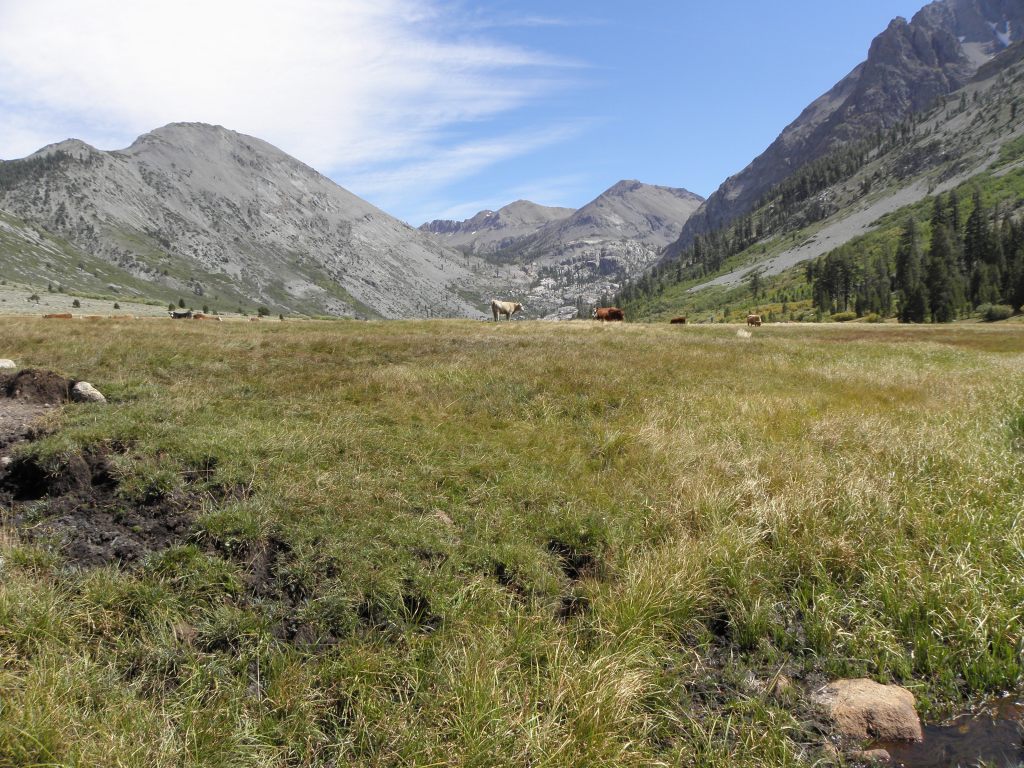
Looking South towards Kennedy Lake
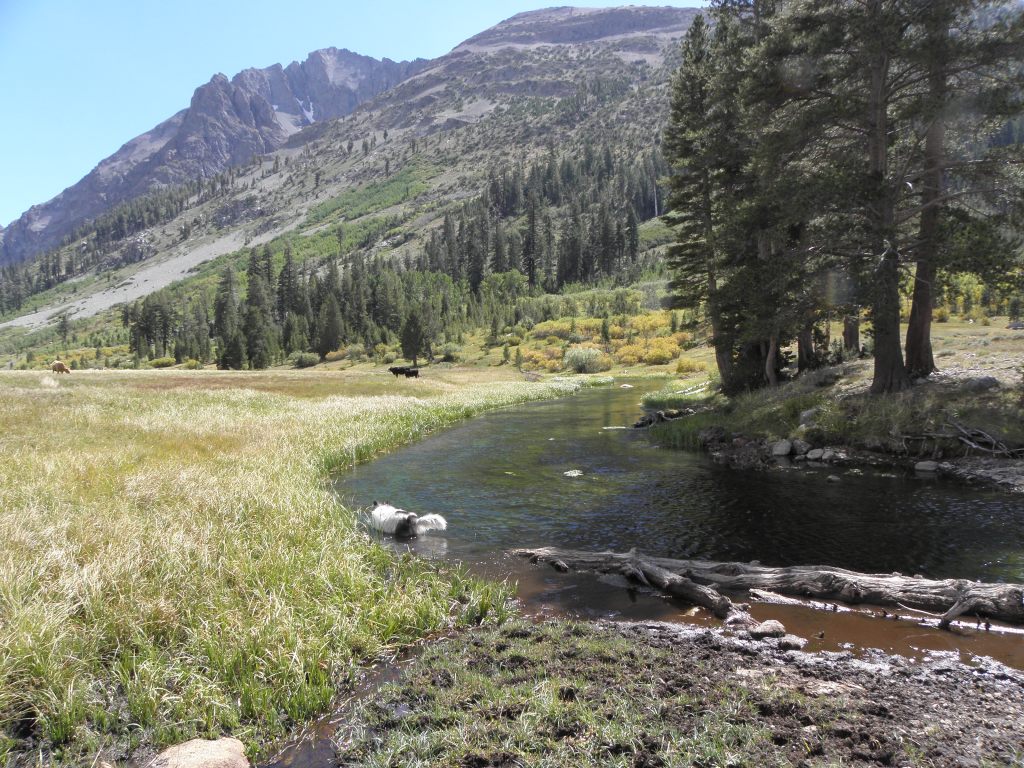

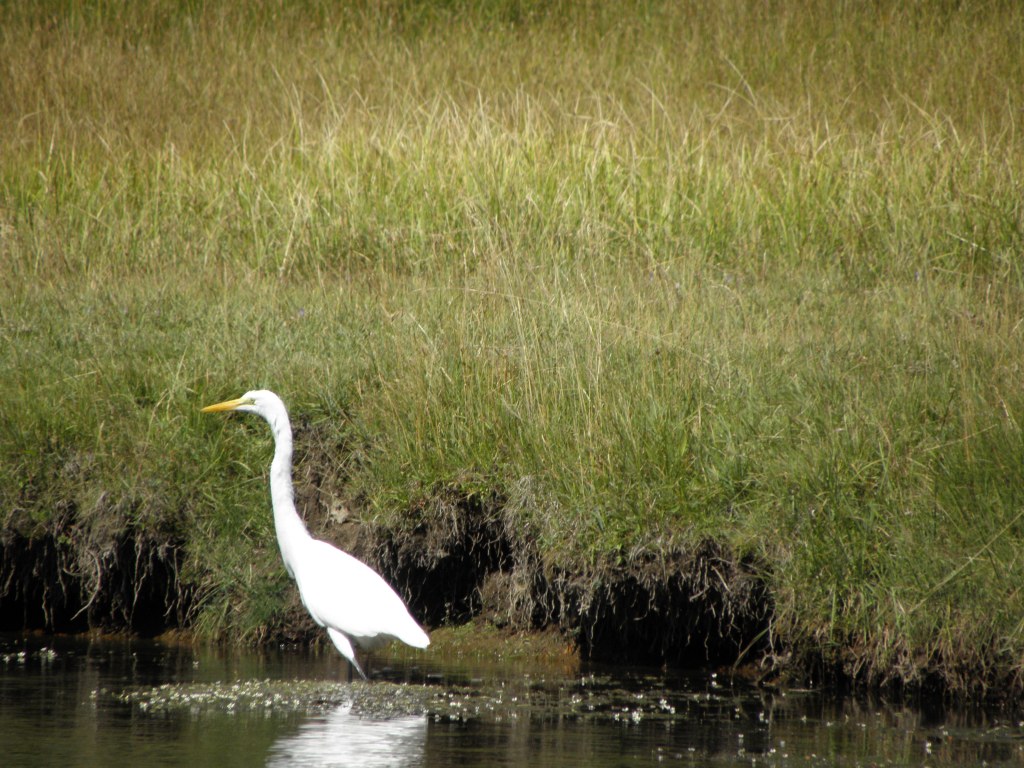
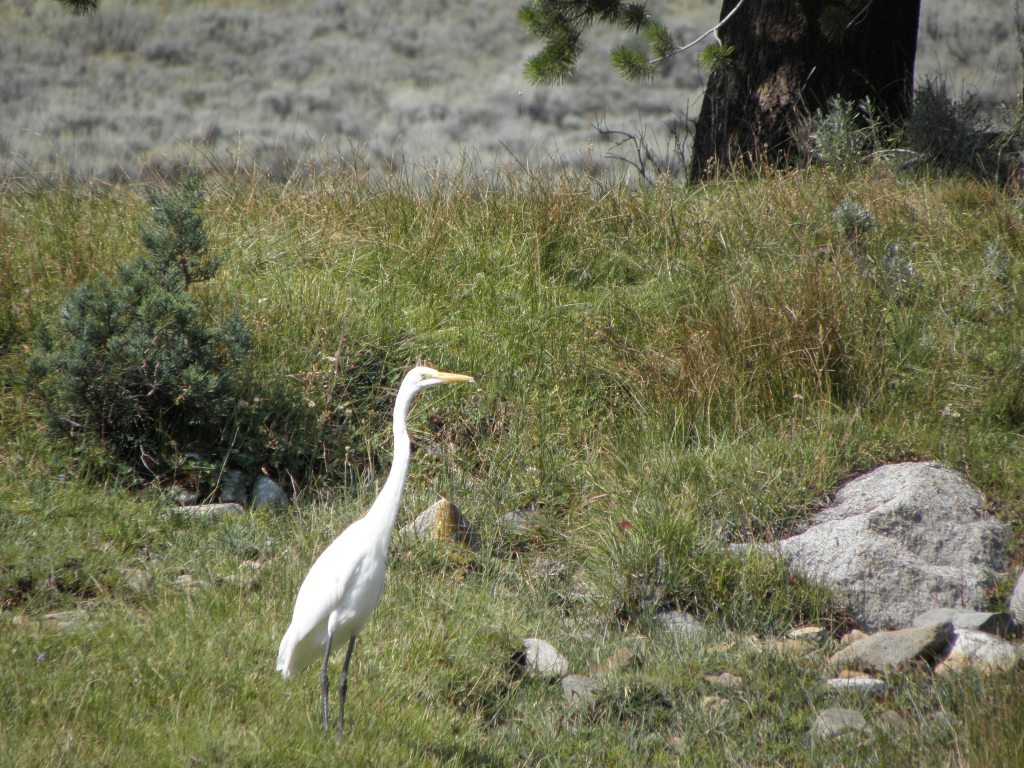

I spent the early part of the day organizing the camp, then mid-day Marilyn, Shiloh and I walked to the aspen grove looking for edible plants. To my surprise and disappointment, the whole area of the potential wild edible plant garden was only nubs, or completely gone – eaten by the cattle. The whole area looked like a war zone trampled by the cattle. The cattle devastated pretty much the whole area. I was able to find some new growth stinging nettle I brought back for tea. There was also some yarrow in the area that I still have not tried for a tea.
It is interesting where plants grow in different habitats. It seems a lot of plants like being around aspen, where in the forested area the plants are limited to just a very few, with the exception of wild mushrooms. And then you have the meadows, sage brush areas, along the streams and in the rocky areas that provide other species of plants. Nature gives us a road map of where to find certain plants in different habitats. It takes a lot of observation to learn where to find what, but in the end it is well worth it. There is a lot of time saved searching for plants if you know where to search. It is a great survival skill and makes it fun and interesting knowing where certain plants might be, and what habitats they like.
Later in the afternoon Shiloh and I went to gather firewood while Marilyn began obsessing again, not about bears this time, but about wild edible mushrooms. I brought a book on mushrooms and she was glued to the book. While I was getting firewood, she was on the search for wild mushrooms. There were quite a few different types of mushrooms in the forested areas this time of year.
Before dinner we walked to the spring to get some fresh water and on the way back I picked a leaf from a plant in one of the many small streams that ran through the meadow, from the mountains and ate it thinking it was water cress. It grows abundant in these streams and in the small pools of water in the meadow. It did not have the strong peppery taste. It actually had a very pleasant sweet and very tender taste to it. It was very good and would have made a good salad green, that is if it was not poisonous. I didn’t die or get sick, but I shouldn’t have done it. The number one rule is not to do is, in what I just did – eat any plant that is not properly identified. I believe I was being careless, because Marilyn was there and I was being a guy. Simply, plain stupid on my part.
Having Marilyn along makes a big difference in how I think about things and handle things. The level of comfort and confidence is high, and that is when we tend to do stupid things. When one is sharing an outdoor experience with another person it seems all the scary thoughts don’t enter the consciousness, unless one finds oneself in a survival situation that can stretch ones limits even with another person sharing in that experience. It can be a good thing or a bad thing depending on if the two people (or group of people) are able to work together or pull away from each other through the potentially stressful conditions of survival. Because I was sharing survival skills with Marilyn and at the same time being aware of different situations, it did help me stay somewhat focused on being in a survival mindset. But again, I was much more relaxed with another body there with us.
Can another person make it a positive situation or a negative situation in a survival situation? It can work both ways. With another person, if one is too confident, too comfortable, or too cocky, one can make mistakes or take foolish risks. People will have a tendency of pushing themselves with other people potentially causing a dangerous situation. A good example is eating that plant I did not identify properly. It could have made me very sick or even could have killed me. I would not have taken that risk if I was alone. Jumping ahead a little, I continued eating small amounts of that plant two other days. Because I did not having any negative reaction to the plant I felt it safe, but it still could have been risky. The benefits of course with having another person in a survival situation is having that companionship, support of each other and sharing in the responsibilities in survival. Being alone in a survival situation, one does not obviously have the support and has to rely on solely oneself. It would take more discipline having to do all the work required to survival and in a survival situation, one cannot just sit on their morals and hope to get rescued or survive the situation. And possibly having to deal with the loneliness factor.
I decided not to focus on actually doing survival skills with Marilyn there. I was mentally going through different scenarios in my mind, but there were too many distractions with Marilyn around. I did focus on the art of observation and awareness skills while she was there. But I also wanted her to enjoy herself in her experiences in nature, and for her to not feel alienated from us.
In the early evening we met up with two bow hunters just outside our camp. They used the same log bridge we used to get across the creek. We chatted for awhile and they had mentioned running into a sow and two cubs in the area, and that really got Marilyn going with the bear thing again. She wanted a gun that I wouldn’t give her. Instead I gave her two rocks, nice rocks with a nice sound, and sent her to bed. She tapped on the rocks for awhile in her tent just for practice. I guess to make sure they worked. I had all the guns in my tent as with Shiloh that she felt was unfair. I really did not think to much of the bears as being a problem, I had my own tapping rocks as well. It is very rare for black bears to attack humans, but they can do a lot of damage to camping gear, as with getting into food. But there is always a slight risk of a black bear attacking. Years ago I let a friend use some of my camping gear for a backpacking trip he was taking with friends. Their trip was short lived after a bear destroyed their camp. Me and my friend, Greg had two close bear encounters, and while camping in an area where there was a warning to campers of a mama bear, and two cubs prowling around in campsites in the backcountry. We got sightings from other backpackers that they saw the bears, but fortunately they did not bother us. We did find a few ripped up backpacks along the trail.
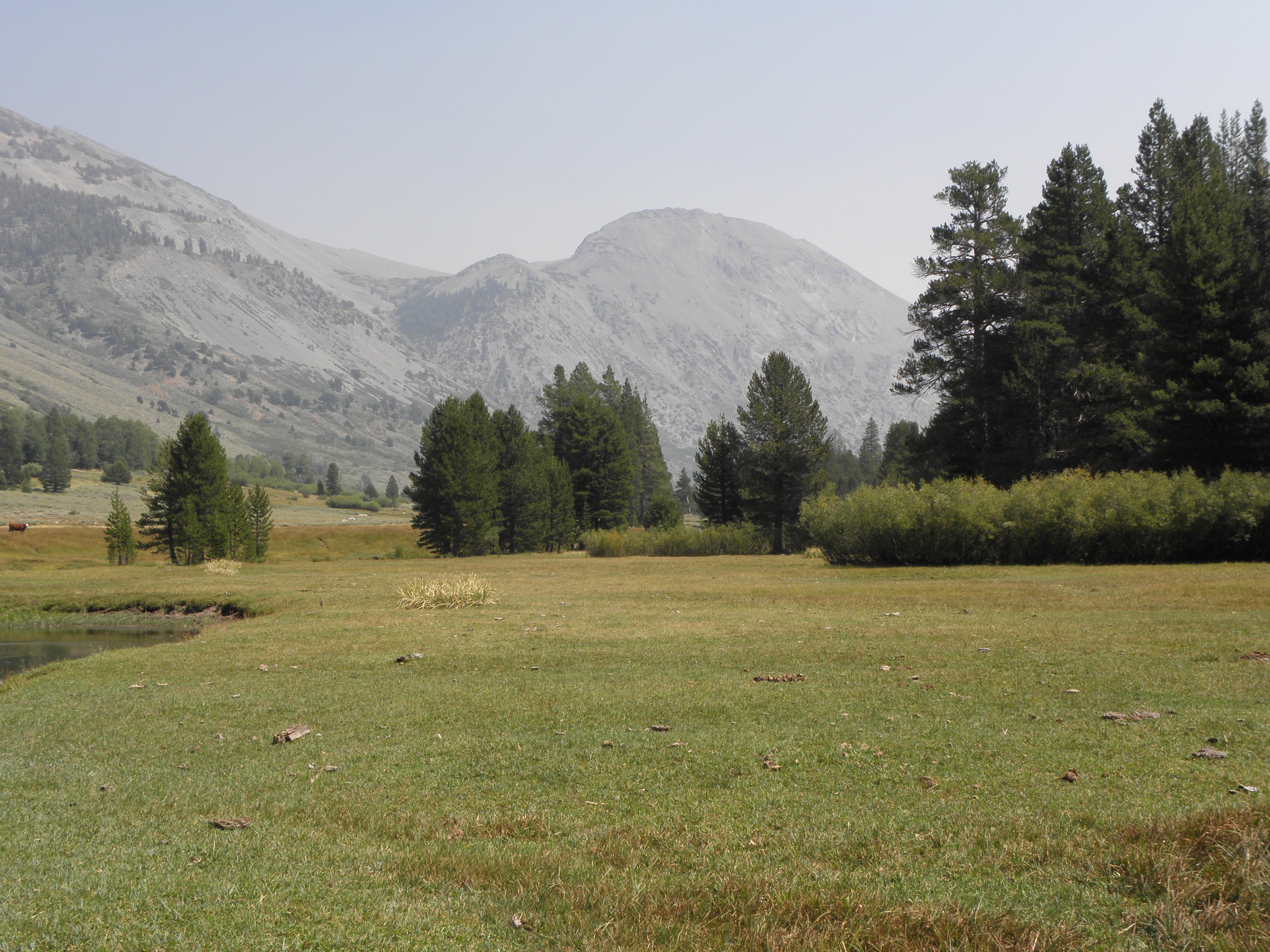
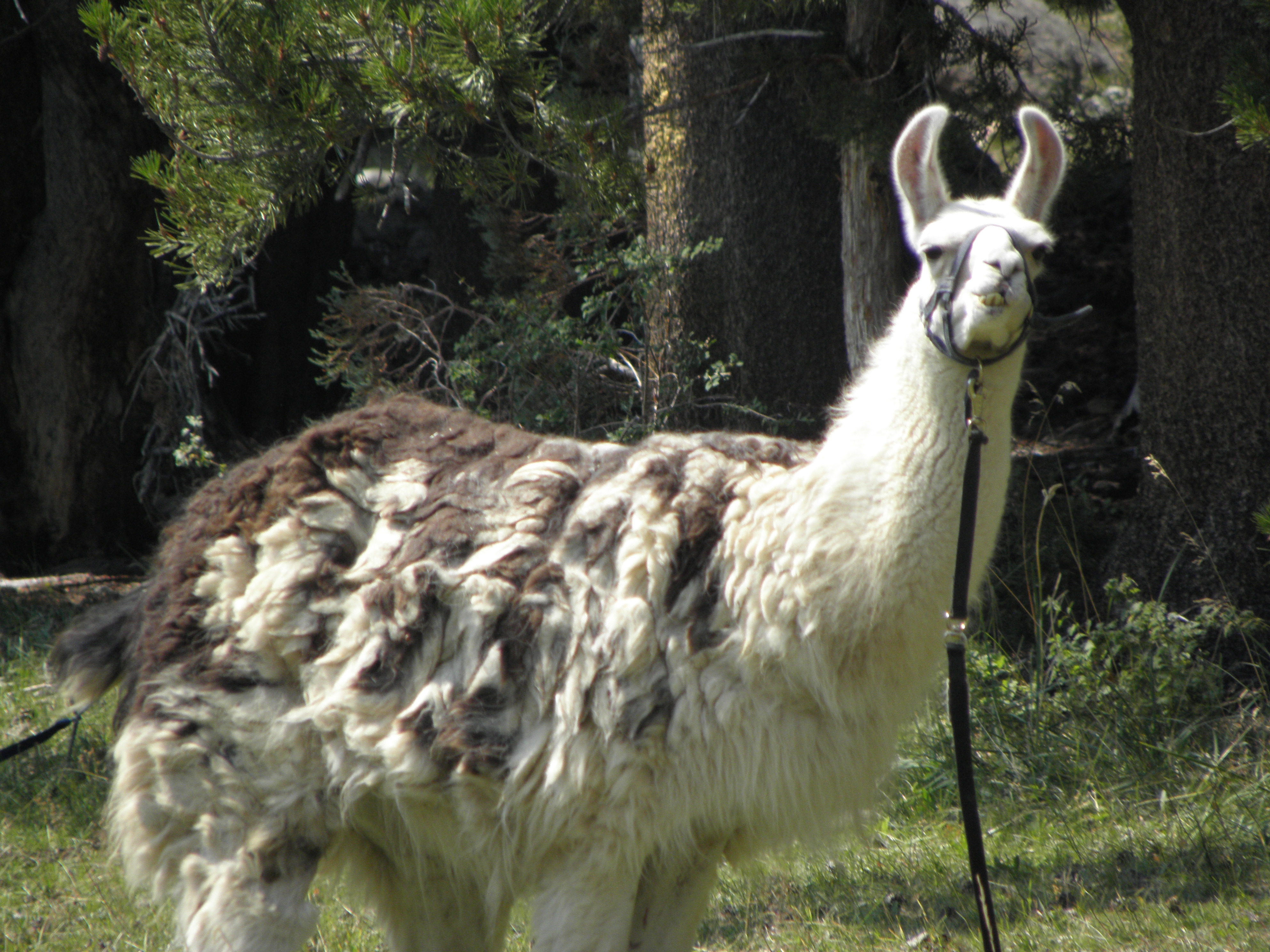

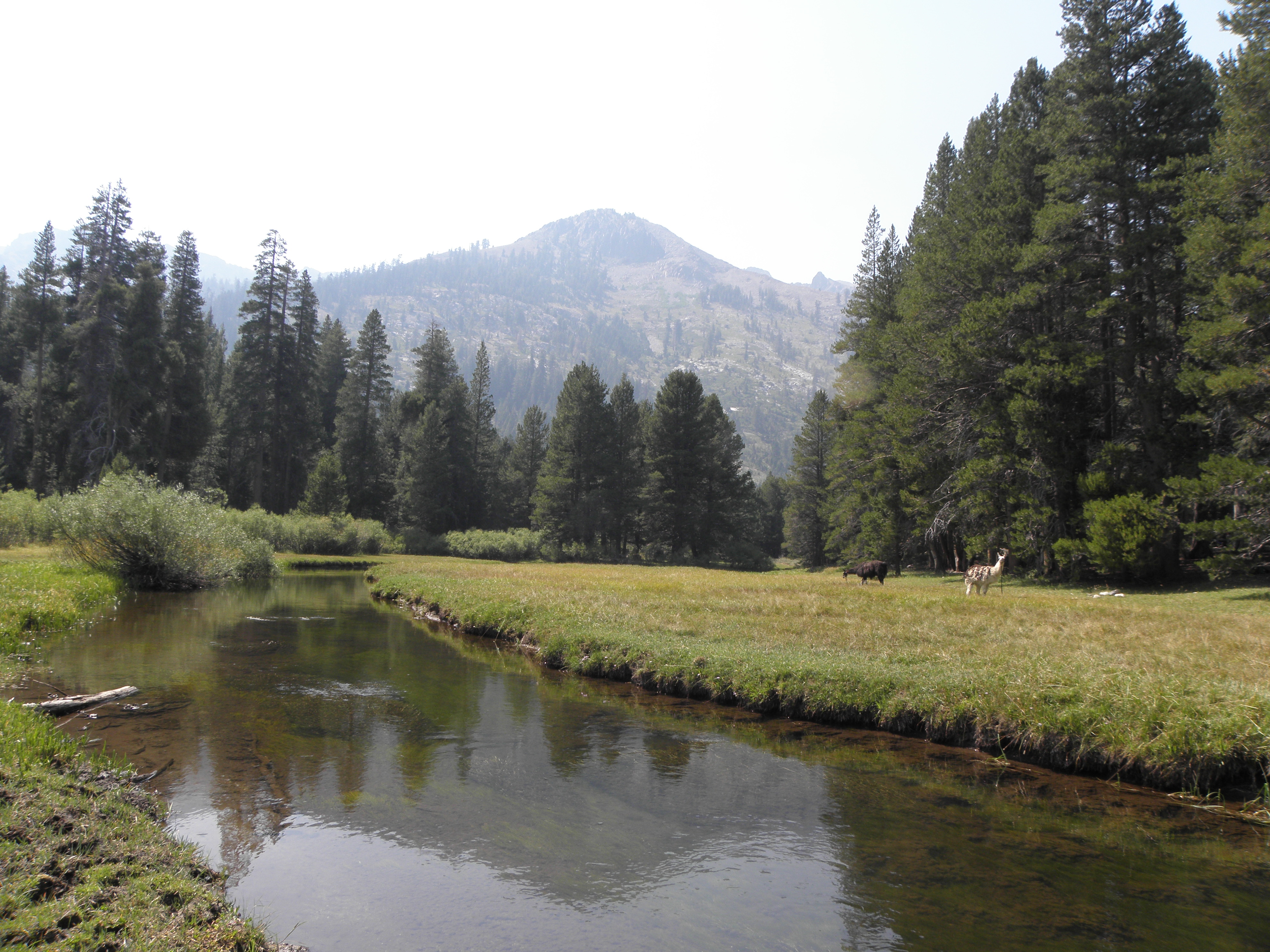
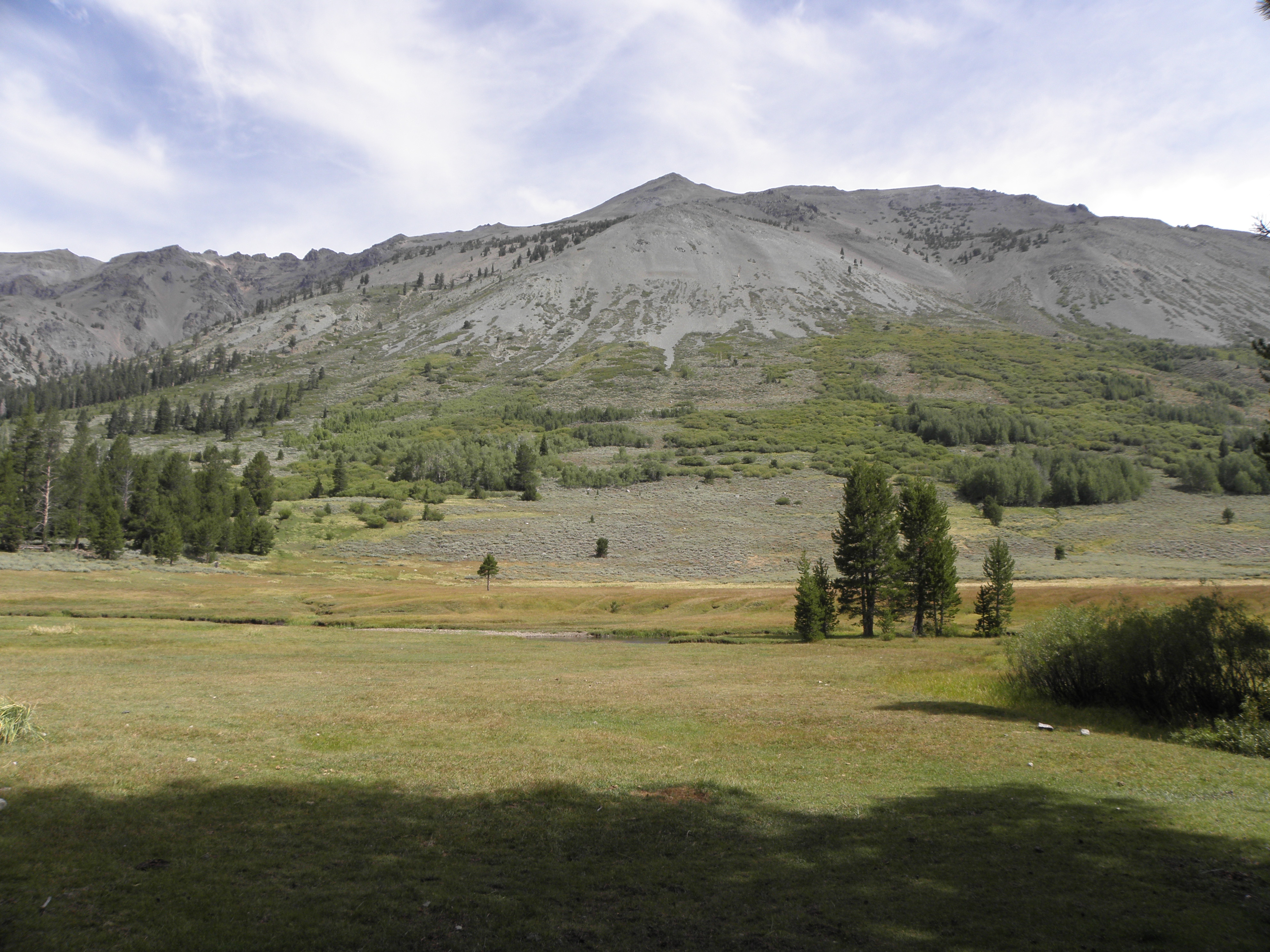

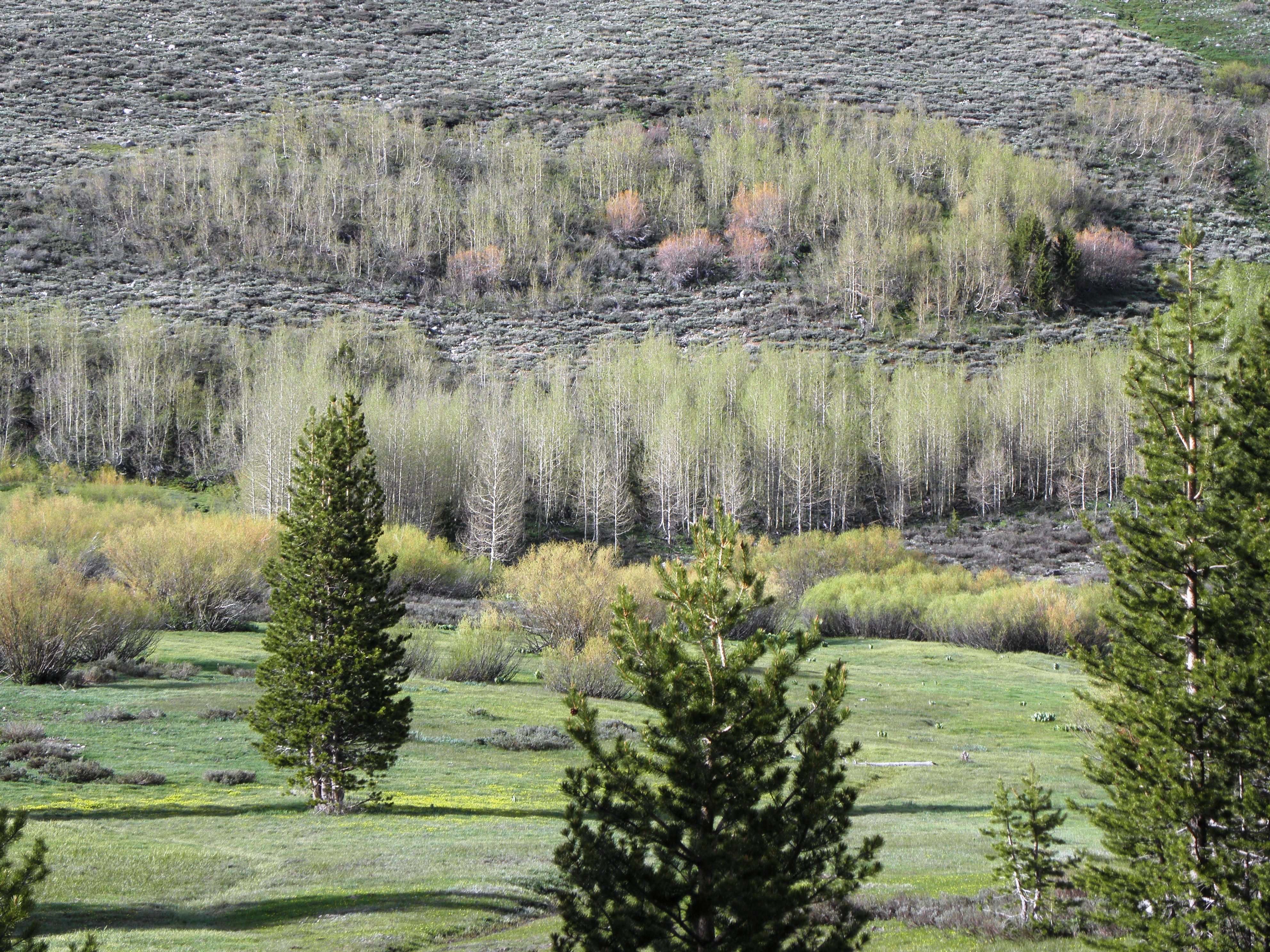
The reason I suggested to Marilyn that tapping on two rocks will scare bears away, is that originally I heard it on a TV series years ago called the “Waltons”, where one character named John Boy was out in the woods alone and came upon a black bear. He was told to strike two stones together to scare the bear and on the TV show it worked, of course. On my first very close bear encounter coming back from four days in the backcountry with my friend Greg, I was resting on the trail, exhausted from a very long hike and used my backpack as a pillow. I heard something behind me next to my head and I got up to look, and I saw a black bear take off down a steep embankment towards the lake. I actually scared him and thought I won’t be seeing him anytime soon. I yelled to Greg a short distance down the trail, sunny on a rock, and he ran over looking for the bear. Well, the bear did come back, because he knew there was something good in the pack. I think the only thing I had in my pack was a candy bar wrapper. Both of us at the time knew nothing about how to deal with a bear, so we started yelling and chasing after him and he took off for a very short distance, then the bear turned and began chasing us. And we turned and ran for a very short distance and this went on going back and forth a few times. It was a young bear. We were thinking how are we going to get rid of this bear? I guess I could have just given him my backpack, but then again, I did not want him ripping it apart. Unknowingly to Greg why he did it, he picked up two rocks and began striking them together and in a second the bear took off running, never to be seen again. I asked Greg how did he know to do that? He responded, “I don’t know, I just did it.” I told him about the Waltons’ story I watched with John Boy doing the same thing. It may be something you might want to try and see if it works for you if you encounter a pesky bear. If the bear is actually stalking you or you know the bear shows signs of being sick, you want to consider having bear spray or a gun handy and leave the area immediately when you can by walking slowly away from the bear. Never run! If a bear is stalking or potentially sick, he or she could be very dangerous and is more likely to attack seeing you as a potential easy meal. Never assume it will be a nice cuddly bear, and of course, never, ever feed a bear. Studies have shown that bear spray is 50% more effective then using a gun for a bear deterrent. If you have to spray the bear in this situation due to a bear attack, leave the area immediately and report it to a ranger. Also keep in mind that usually black bears will stay away from humans unless they are habituated to humans and relate humans to food. Never leave food around in camp and never, ever feed a bear. For that matter any animal. Bears can smell food many miles away with their incredible sense of smell. The average dog’s sense of smell is 100 times that of a human. A blood hound’s is 300 times better. A bear’s sense of smell is 7 times better than a blood hound’s or 2,100 times better than a human.
Tonight we had marinated chicken breasts and salad for dinner. Marilyn tried the stinging nettle tea and liked it. Marilyn ate much of what I brought even if it was not the healthiest, she is overall a healthy person, eating healthy foods. She brought along bean sprouts that we were able to actually grow up here, and enjoyed eating. I also consider myself a pretty healthy eater, but camping seems to always go with bacon and eggs for breakfast. A breakfast I am sure a bear would like to share in.
August 27, 2009 – Thursday
I woke up this morning to the call of Marilyn once again, but this time she wanted a fire for a different reason. She had fallen into the creek from our two logged bridge. She decided to walk across the narrowest log and the wobbliest of the two logs of our log bridge crossing. She didn’t make it across – at least not on the logs. She was soaked from the waist down. I had to give her some of my clothing and a pair of dry shoes. I told her to take all the wet clothes off and crawl into the sleeping bag to warm up, while I got the fire going. I didn’t want to take a chance of her getting hypothermia.
The number one rule in survival is never get wet. The saying goes, “Get wet and you die.” In Marilyn’s case, it may not have been that serious, but some people are more likely to experience hypothermia than others. Marilyn was in incredible shape and she had very little body fat which could have put her into greater risk of hypothermia with the little dip she took in the creek especially if she did nothing to prevent the onset of hypothermia. Water conducts heat twenty-seven times faster from the body if you get wet, sweat, or have wet clothing on than by air. Being in the wilderness whether you are backpacking or in a survival situation, you should always keep yourself dry especially in spring, fall and in winter conditions that can always be unpredictable in the mountains. The mantra when going out into the wilderness is always be prepared for any conditions that may occur and never get wet when there is a high risk of hypothermia. We did have chilly mornings.
The coyotes were howling again in the early morning and not during the night like they had the previous night.
Another beautiful day greets us today with an abundance of sunshine and warmth. A great time to be in the wilderness.
This morning was a no hurry morning. I relaxed and had my coffee, writing in my journal and enjoying the morning Sun’s warmth. Shiloh was relaxing at his spot next to a large pine tree. We had a nice fire going and once Marilyn got warmed up, we started preparing breakfast around 10:00 am. We cooked up some bacon and eggs for breakfast.
We decided we would go to the lake today and we walked by the small stream where I nibbled on that plant I thought was water cress. Marilyn assured me there was water cress growing right next to it. Marilyn was sure it was water cress, so I took a nibble and it definitely had a peppery, bitter taste to it.
It was a beautiful sunny day and the walk to the lake takes only about 15 minutes to get there from our camp. We got to the lake around 12:00 pm. Marilyn got settled in on a little grassy area by the water to begin her painting of the majestic mountains, and me and Shiloh headed off to try our luck at fishing. We found a spot that looked pretty good were the meadow and Kennedy Creek met, just below the lake outlet. Shiloh lied down on the wet grass and watched what was going on in the surrounding area, and keeping an eye on the cows. After a few casts using a lure I had a fish on the line. It took about another half hour to catch my second fish. They were both brown trout. We were going to have fish dinner tonight. I fished a little bit longer then returned to where Marilyn was sitting. I was pleased with the two fish. That is all we needed. Marilyn was gone from her spot, slipping away where she had taken a little dip in the lake further along the east side of the lake by some large rocks. When she returned, I was cleaning the fish. I brought a crayfish trap with me and wanted to try it out, so I put the fish guts in the trap and set it at the beach we were at. We then got everything packed up and left for our return walk back to camp. Although much of the meadow is a bog, it makes for a nice, beautiful and relaxing walk with a great view of the mountains on both sides and beyond. On the way back we picked some sage brush and some water cress to stuff in the trout. I also showed Marilyn the campsite we stayed at in June. We cooked up the trout for dinner and it was delicious. Nothing like fresh trout.
We talked to the hunters again for a bit when they were coming back from their hunt. They were empty handed – no deer.
That night we chatted next to the campfire. It was the warmest night we have had so far.

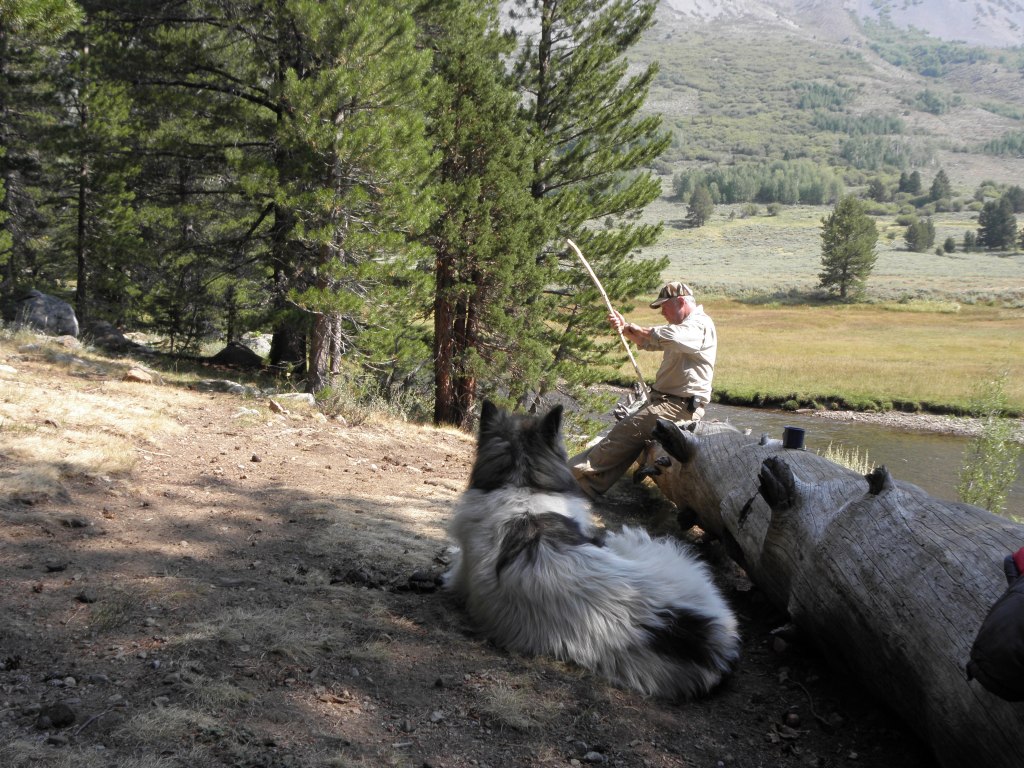
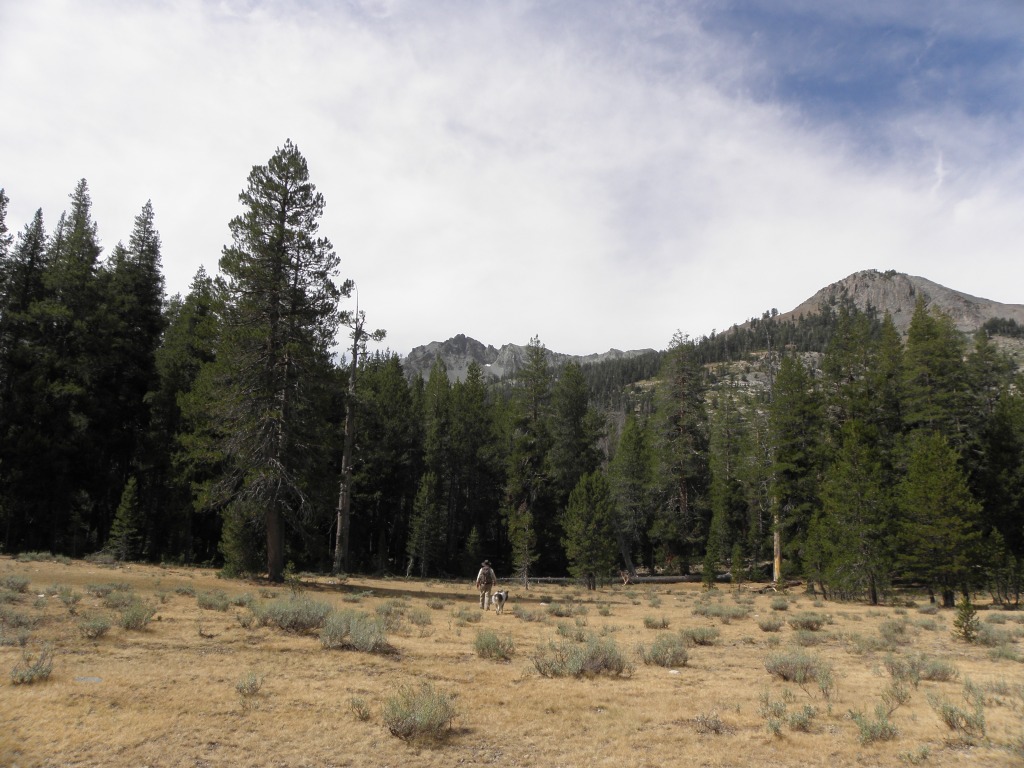
August 28, 2009 – Friday
I slept pretty good last night, but had a tad too much whisky and Baileys Irish Cream last night. But it sure did taste good. I was having a difficult time talking with Marilyn. I don’t mind feeling a little buzz once in a while when having a drink, but it was starting to go beyond that. For some reason I did not offer her any. I guess I just assumed she didn’t drink. Very rude on my part.
This morning it was 40 degrees at 7:00 am. It is starting to warm up with the Sun above the mountain ridge top. The clouds and wind are coming in – maybe some rain. It is incredibly beautiful up here, beyond description.
The two bow hunters turned into three hunters now and their camp was not to far from ours. They go through our camp whether they are coming or going to get to the log bridge. Marilyn spotted a plastic bag hanging from a tree next to the creek this morning. She opened it up and it was venison. The hunters left it for us, so we had it for breakfast. What a nice treat. We thought that was a very kind gesture and was hoping we would see them again to thank them.
Today Marilyn, Shiloh and I did a little exploring in the woods. We found a nice campsite not to far from us and in the northerly direction. Shiloh and I were looking around for anything that was of interest, and Marilyn was searching for, guess what? Mushrooms. The area of woods we were in got pretty thick with downed trees and underbrush. Marilyn went her way, Shiloh his way, and I went my way. But we were always near to each other, but not necessarily visible to each other. Marilyn was yelling at me to come over to where she was so she could show me a mushroom. I responded back to her with a shush. I was practicing being silent and just listening, and I could hear both Marilyn, and Shiloh making a lot of noise going through the brush. I told her she does not have to yell, but just listen and she will know I am close. But she was excited about the find she made.
Marilyn and I thought we saw bear scat in the woods we were going through not far from camp. A good indication, we have to be careful not to leave any food scraps laying around, or any smells, that will attract bears.
After an hour or so, we found ourselves back at camp. Marilyn grabbed the mushroom book and began searching through the pages to discover what she had found. She was determined to find wild edible mushrooms. I should be calling her, the Mushroom Lady. I think she read the whole book in a couple of days. We did determine one mushroom that we believed as being edible, and both I and Marilyn were trying to be very thorough in identifying it, but we did not do a spore check, I don’t think.
We decided to have it for lunch in an omelet. Marilyn did the cooking, and it was a very good omelets. We didn’t get sick, nor die, so that was a keeper. I made extra sure it was an edible mushroom, at least in my mind, and really did not want to push our luck with misidentifying mushrooms.
I gathered firewood after lunch and then I took a nap. Marilyn was in her tent reading a book (probably the mushroom book) and of course Shiloh was napping too.
It was a good life in the wilderness. Marilyn, was a great camping companion for us.
Smoke began coming into the valley and the smell of fire was in the air. A forest fire was burning not far from us and the smoke was coming in from the north. Most of the day was overcast and hazy. I would keep aware of the fire.
In the early evening we all took a walk to the lake to check on the crayfish trap that I set the day before. It was empty with no crayfish. I was hoping we would have crayfish for dinner. On our walk back from the lake, we met some people on the trail, one young girl was all decked out for bow hunting. Marilyn actually knew her and they were chatting for a while. A small world even in the wilderness. We then headed back to camp to get dinner ready. We had the tri-tip steak I brought up and a salad for dinner. Another nice and pleasant evening.
August 29, 2009 – Saturday
This morning we woke up to a comfortable 37 degrees, and clear skies. I slept pretty well last night. My first duties this morning were to get the fire going and the coffee perking.
Sitting at my spot I sit at every morning to write in my journal, I was looking around and I spotted a grove of willow close to camp. It has new and old growth and thought it might be a good place to get the wood for my various survival tools. When I walked over to that area, I found a good source of firewood as well. It was a good find.
Marilyn was going to be leaving in a couple of days and I began having these haunting thoughts of being alone for two more weeks. But at the same time I felt very comfortable up here. I am sure it was due to having the company of Marilyn keeping me at ease. Being alone is really not the issue, but being isolated and alone is. Shiloh and I camped for a full month in April and never felt alone. Even if the campgrounds were slow there were still people around.
Today, Marilyn, Shiloh and I went on a mushroom expedition once again not far from our camp and I found myself becoming more in tune with nature and my surroundings. I was also becoming more interested in mushrooms after having that tasty omelet the other day.
At this point of my learning curve in the wilderness, mushrooms were really not on my agenda for things to learn about until Marilyn came along and changed that. I also discovered, I wanted to learn everything about nature. It was a consuming force in my life as with learning bushcraft skills. I believe for some, it brings us closer to nature, feeling more connected.
We found a clump of mushrooms we thought might be Honey Mushrooms. Marilyn was convinced they were edible and wanted to use them in another omelet. I did not want to push our luck with the mushrooms so I said, “No.” She respected my answer, although I am sure she thought I was over reacting.
The feelings of a subtle fear and uncertainty I am experiencing I am trying to understand why I have them, and then just experience those sensations, just allowing them to be there. It also has to do with the fear of failing, the idea of not being able to live in nature, and not feeling one with that relationship, in the grasses, the plants, in the trees, in the animals, and to all life, whether I am alone or with someone. It is a challenge to overcome these demons that haunt my consciousness and at the same time I feel at peace in this beauty and the grandeur of the wilderness. Another thought that came to mind was, will I become bored?
I noticed today the gooseberries are beginning to come out in abundance on certain plants. I love those gooseberries and the tartness they have.
Back on the camping trip Shiloh and I took in the eastern part of the Sierra Nevada mountains in July, I found a nice straight branch of Alder that someone had cut and left. It looked like it would make a good walking stick, so I brought it home with us. I stripped the bark, did a little scraping and wah-lah, I had myself a nice walking stick. This trip was the first time I got to try it and it worked well. It is the first time I had ever used a walking stick and it has many uses other than an additional support in walking. Crossing streams a walking stick can be very helpful in getting across safely by giving you needed support, and balance. It can also be used in getting through brush; protecting your eyes from tree branches; determining water depth; or the depth of mud or snow; the use as a digging stick or moving a rattlesnake away from ones path of travel.
Marilyn wanted a walking stick for her hike back to Kennedy Meadows, so today I made her one out of willow while Shiloh was lying down next to me watching my handy craftsmanship work in action. Marilyn told me later, she had lost it on the trail. All that work for nothing. Oh well.
In the afternoon I met Marilyn at the spring filling the water containers. Shiloh and I walked over to help her carry the water containers back, I sat by the little stream the spring was creating, and picked what I thought was water cress and had a nibble. It had a sweet taste versus the bitter flavor of water cress. It was the same plant I had a few days earlier. I thought maybe it might be water lettuce, but once I looked it up when I got back home from the trip, it was not water lettuce. It is still a mystery plant to be identified. I sent pictures to a botanist at the ranger station to see if she could identify them and never got a response back from her.
August 30, 2009 – Sunday
Today is the last day for Marilyn’s stay. She will be heading out this morning. Last night was a restless night for me thinking about bears and weird dreams. I did not think about bears until I thought about Marilyn leaving. The being alone phenomenon of all the spooky things awaiting Shiloh and I when Marilyn is gone.
This morning was a cool 45 degrees and a sunny sky.
I will be walking Marilyn part way down the trail back to Kennedy Meadows. She still isn’t crazy about those cows. I was willing to walk here further, but she said she was fine. There are usually some people on the trail if she needs help.
I would learn later on my return to civilization, that she returned home with no problem.
Sitting, drinking my coffee and writing in my journal, I was observing Kennedy Creek, the meadow and a sliver of the mountains that surrounds this valley. A small 3 foot pine tree next to where I sit and the branch from a larger pine extends out directly in front of me blocking part of my view. But when the morning sun hits the pine needles from the branch, the reflection it gives off provides a glistening sheen to it. It brings me closer to this tiny shimmering light that pulls me into it. It brings another dimension of beauty to my writing spot, and into nature. A feeling of both Being, and Oneness with the natural world.
I helped Marilyn get organized for her hike back to Kennedy Meadows. We took down her tent and put all her gear she was not taking with her in a pile protected with a tarp, top and bottom. I would take it back with me when Shiloh and I leave in 18 days.
Marilyn got a late start for her hike back, and Shiloh and I walk just a little ways with her getting past where the cattle were, then we headed back to camp. I had offered to walk with her for a couple of miles, but she said she was fine and just wanted protection from the cows that never bothered us.
Marilyn was a good camping companion and Shiloh and I enjoyed her company. I think she also helped me in my preparation for being alone in the wilderness. I am excited about starting this adventure once again, being alone in the wilderness with Shiloh.
I am gaining a general knowledge of what plants I can eat, knowing what animal life is present for food and knowing the fishing is usually good up here. I went through in my mind things I would like to get done today and for the remainder of time we will be up here, and getting back into the survival mind-set. And into the silence of nature.
Marilyn is now gone and it is me and my trusting friend and companion, Shiloh. I am excited to feel that sense of being alone again in nature. It is hard to describe.
I didn’t mention all the wildlife we saw during these 6 days, because we didn’t see any. It was like the whole area was empty of wildlife. There was one exception, the fish I caught, and if you count the domestic animals, the 150 cows, and the llamas. We saw the Llamas on one of the days, when a woman brought them up for exercise. She uses them for pack animals which has less impact on the environment compared to horses and mules. We also had no problem with bugs. Oh, we heard coyote also, but didn’t see them.
TO BE CONTINUED IN PART 8
